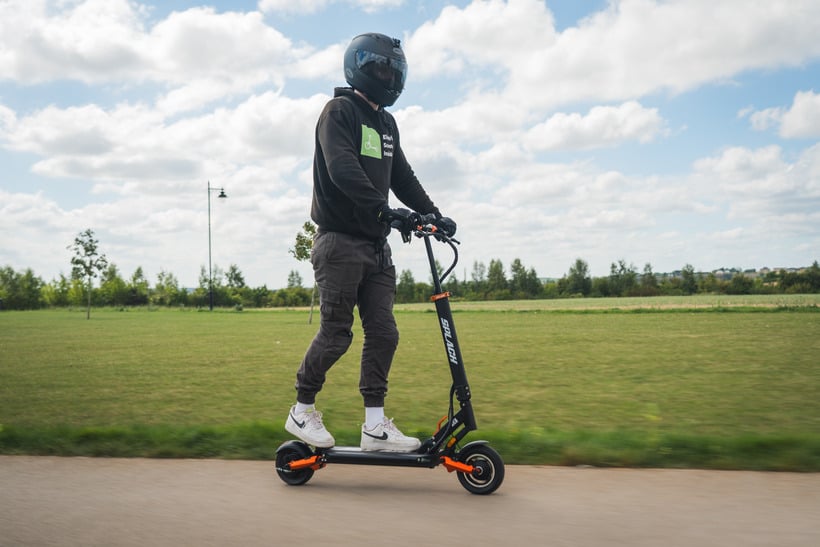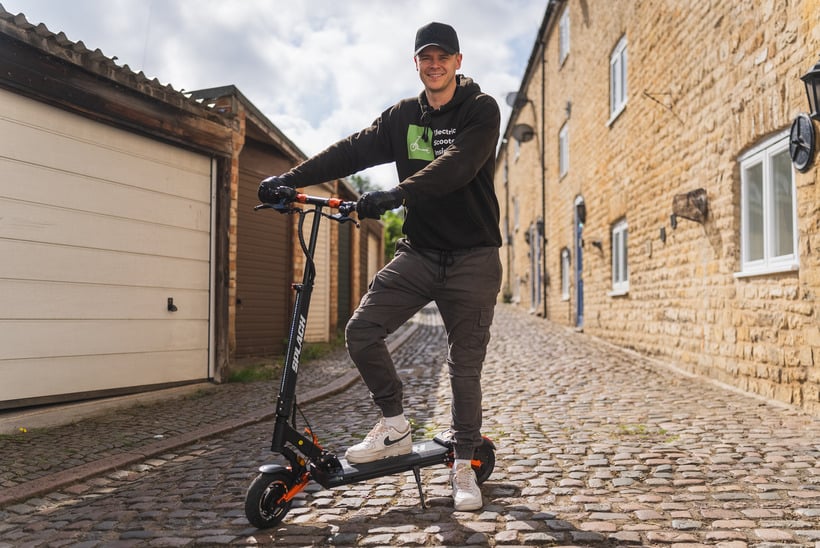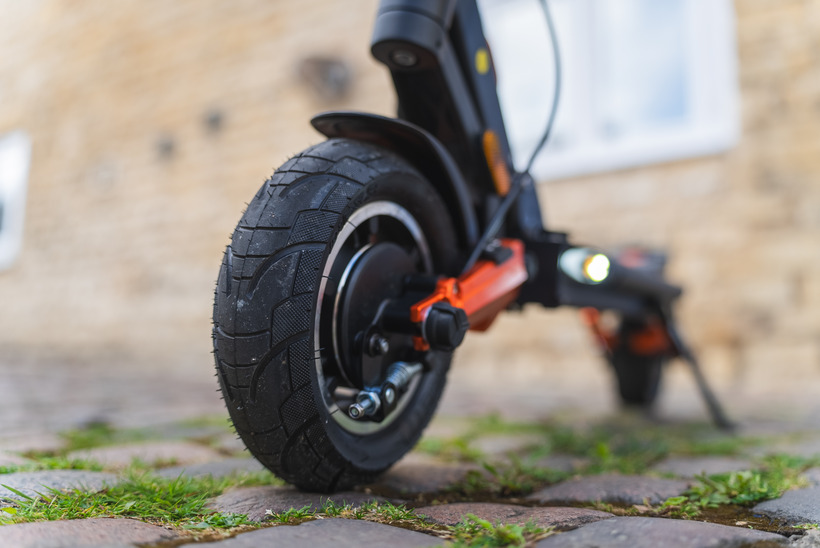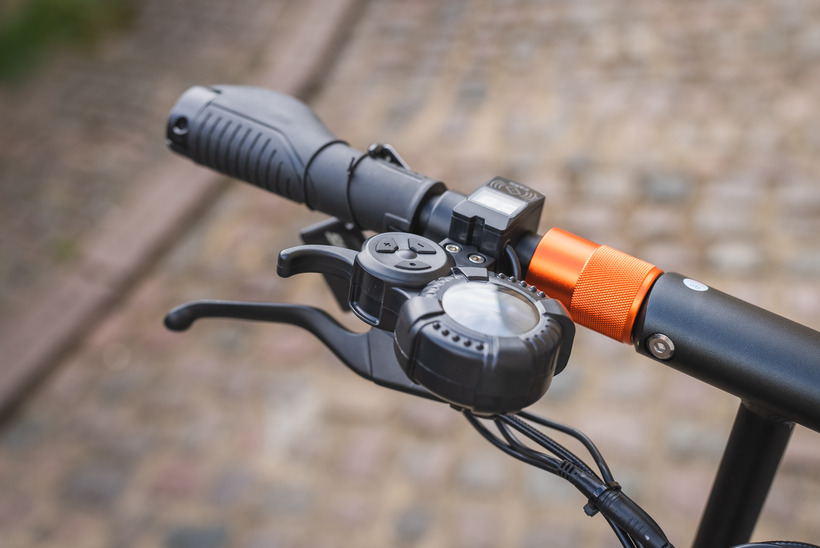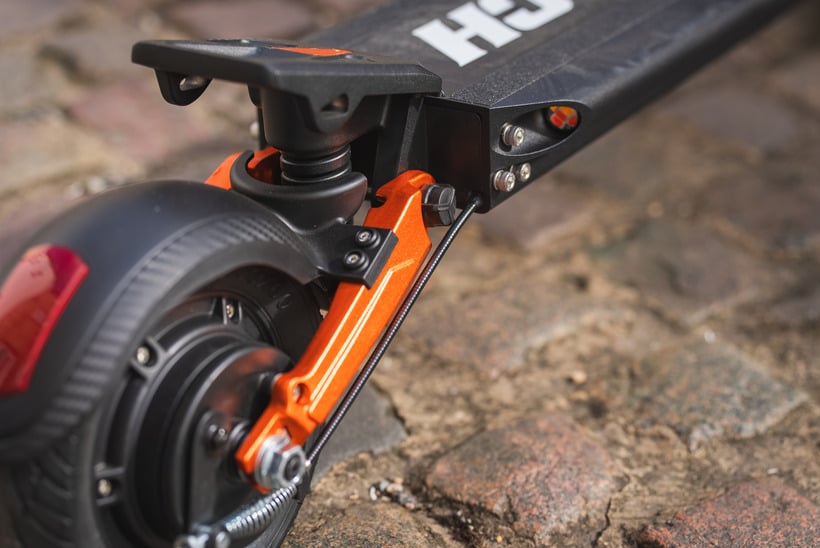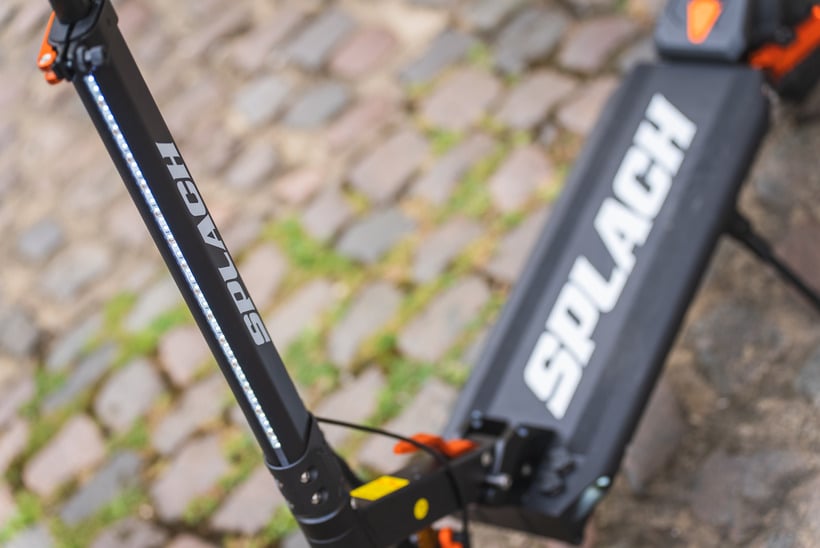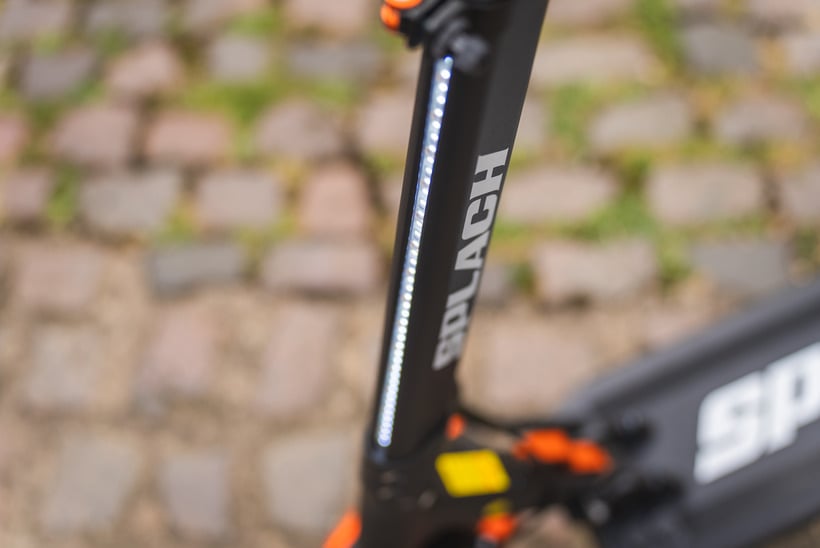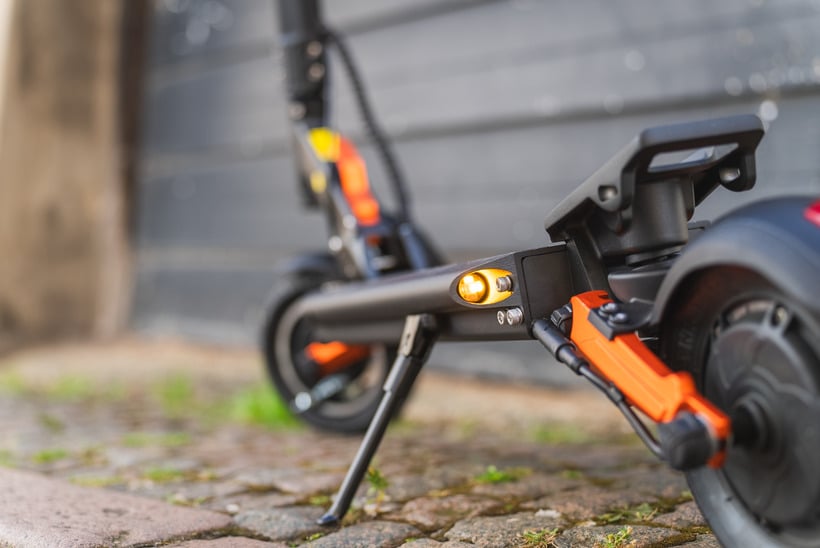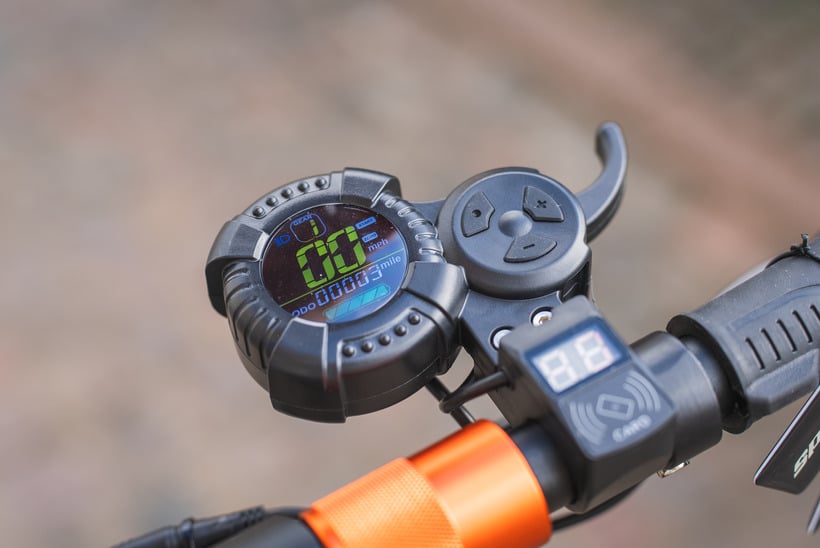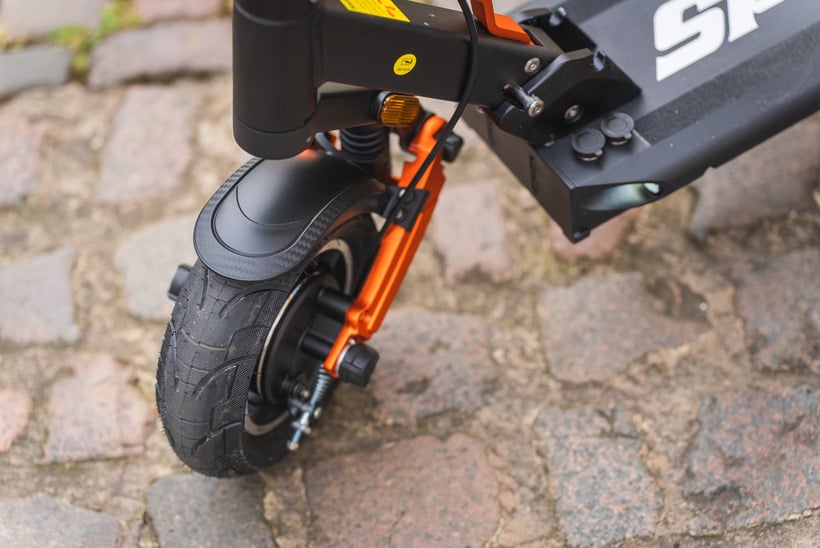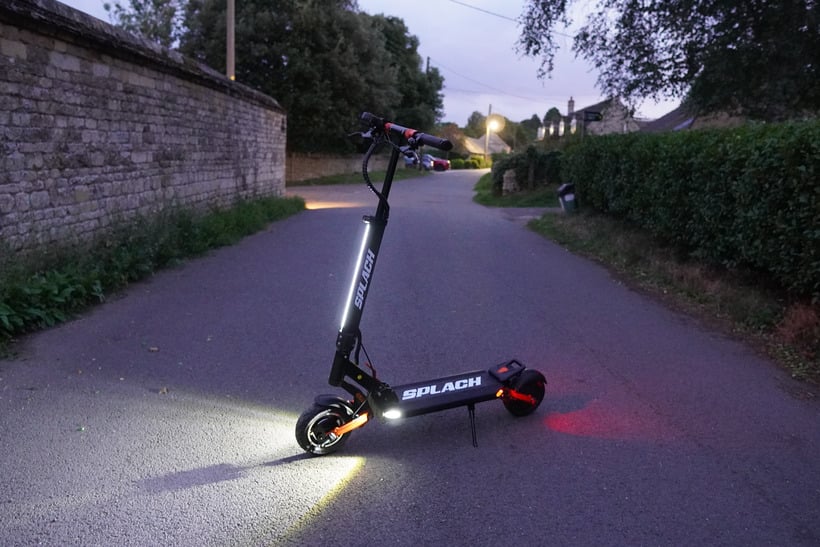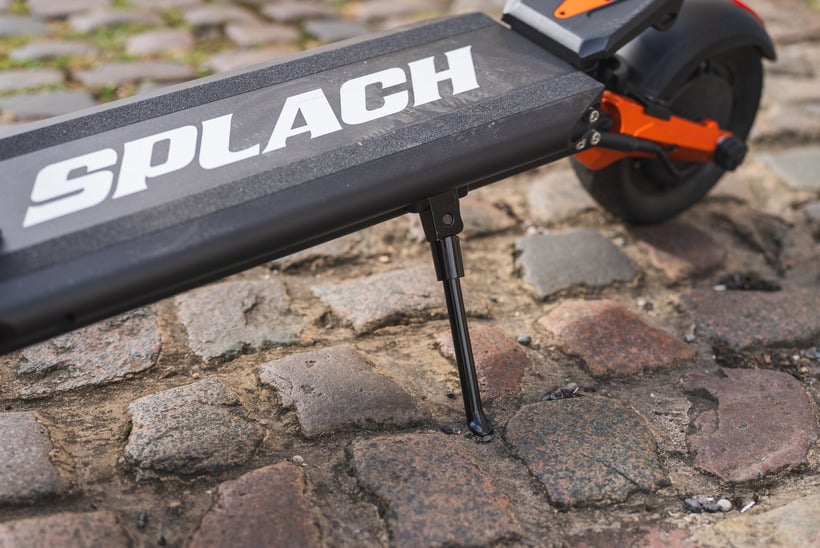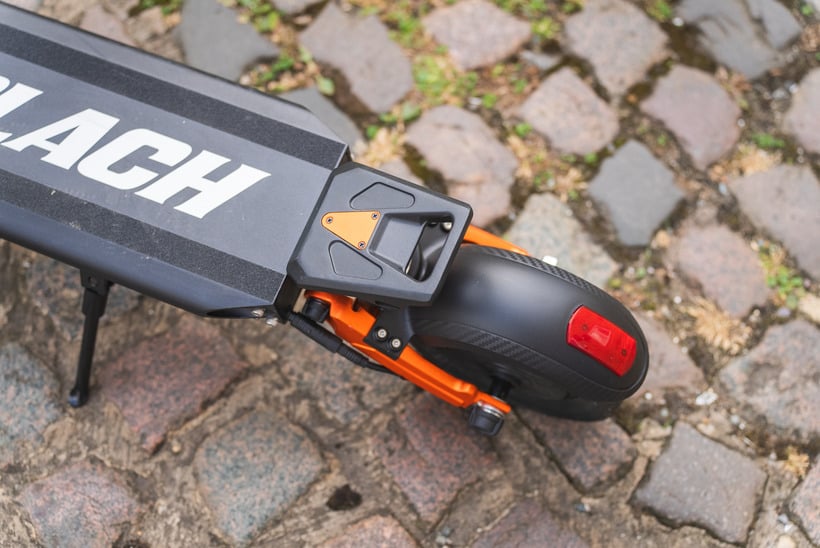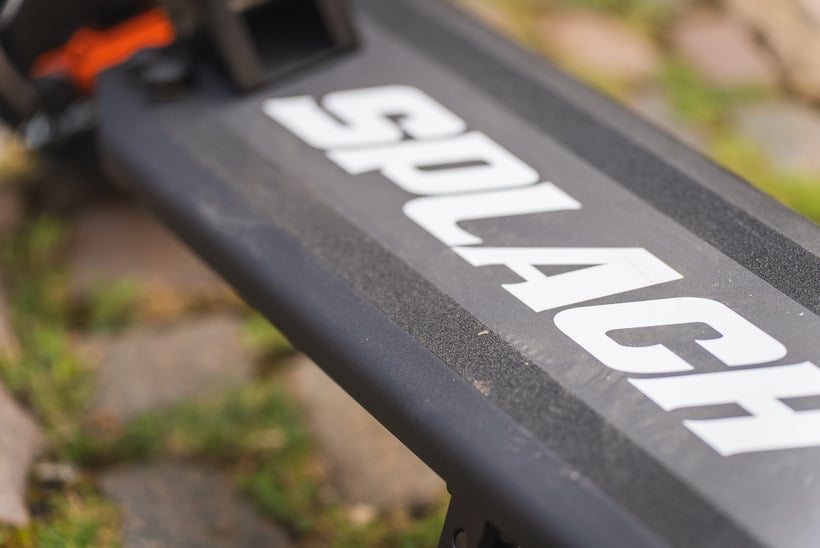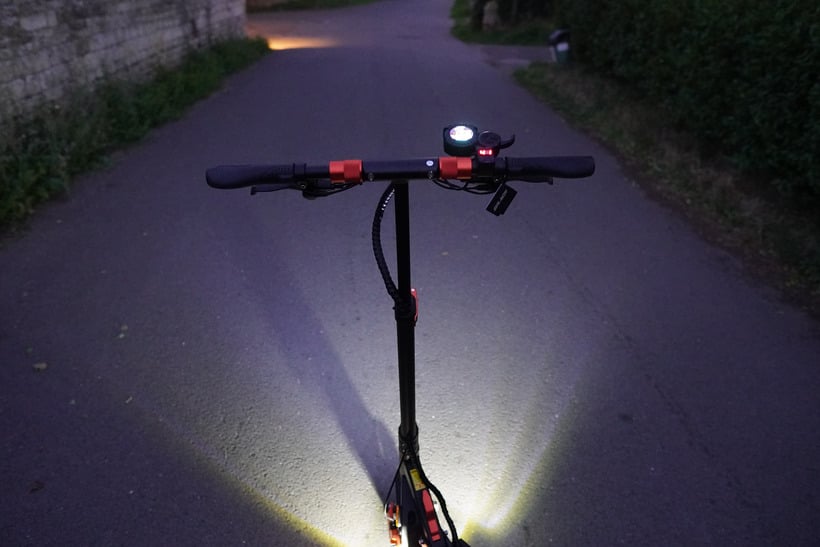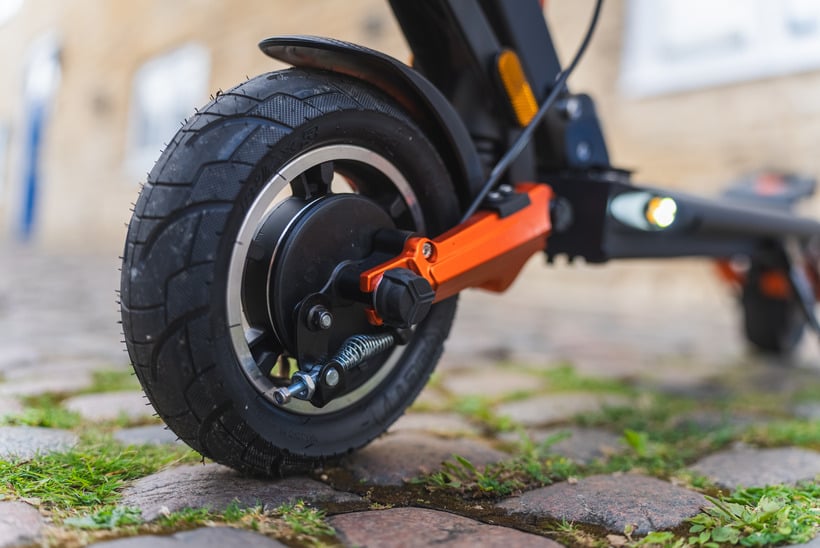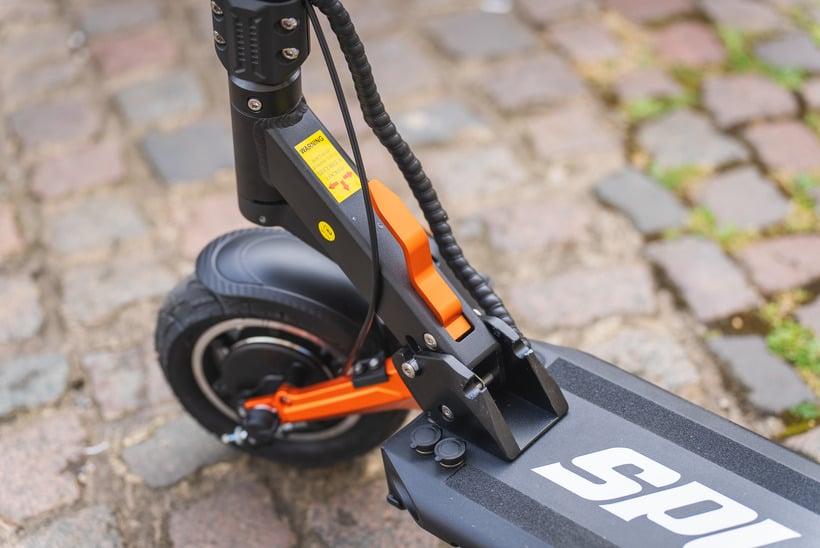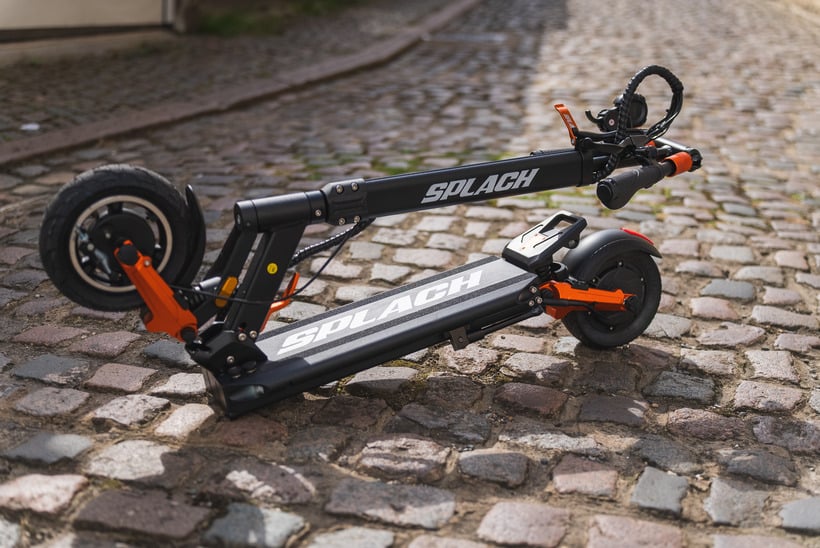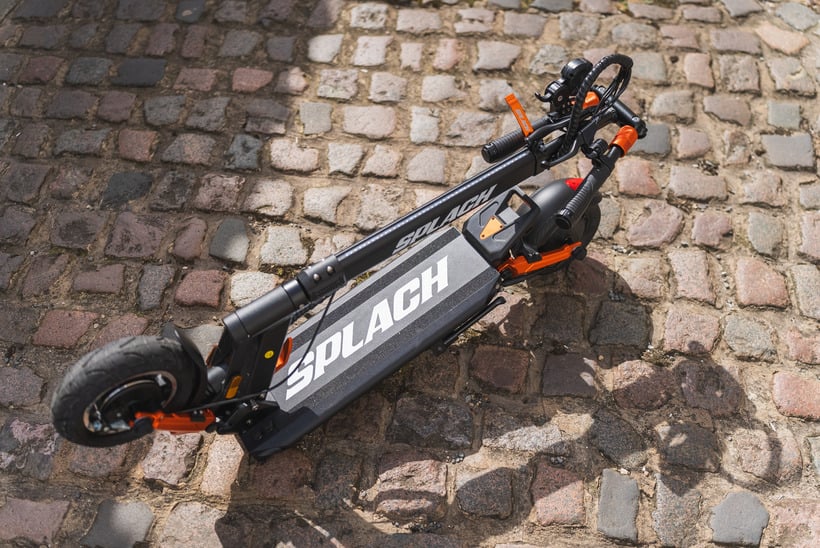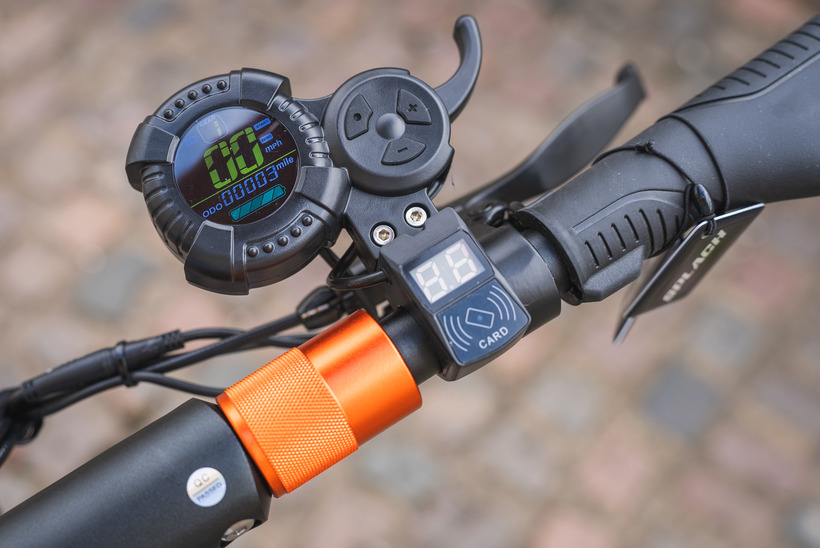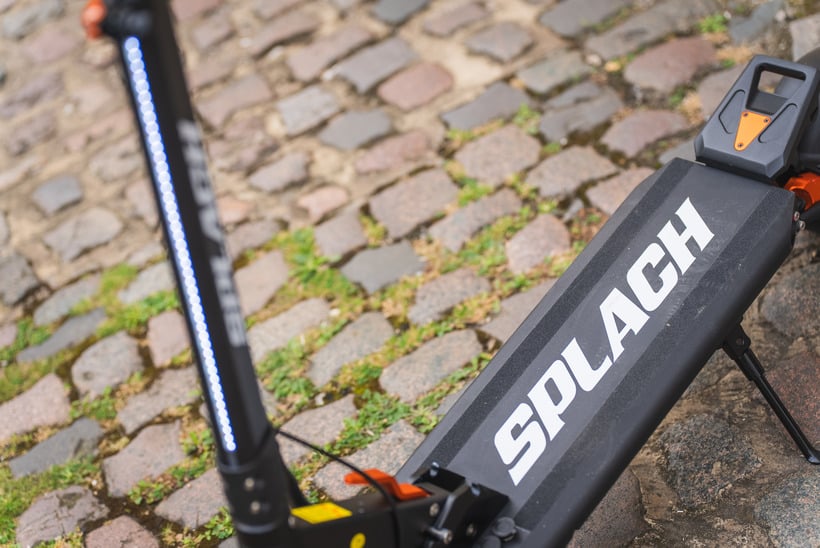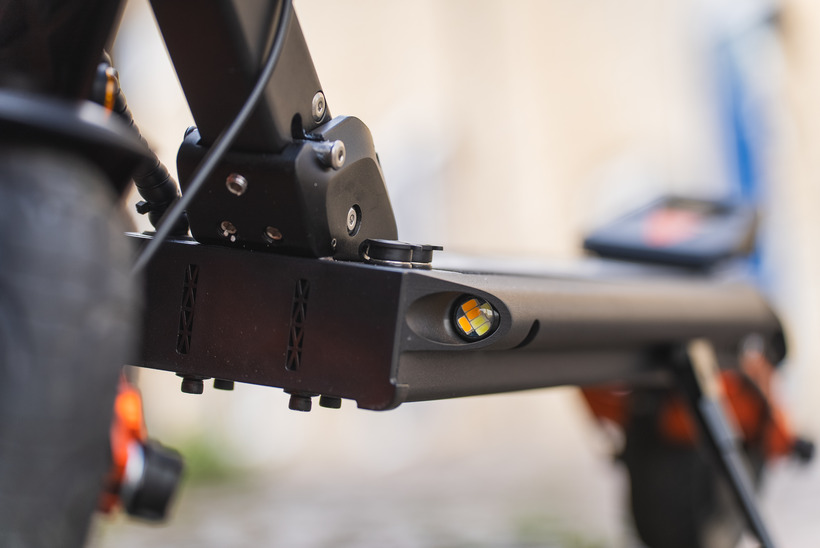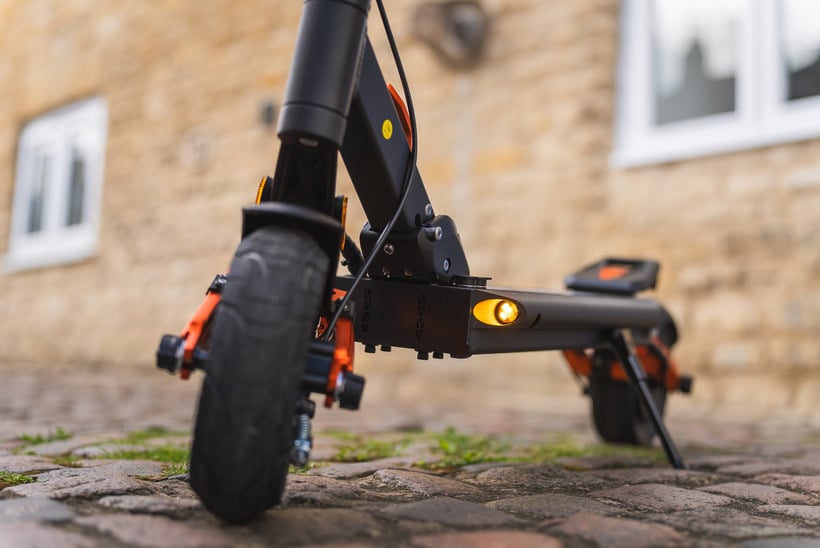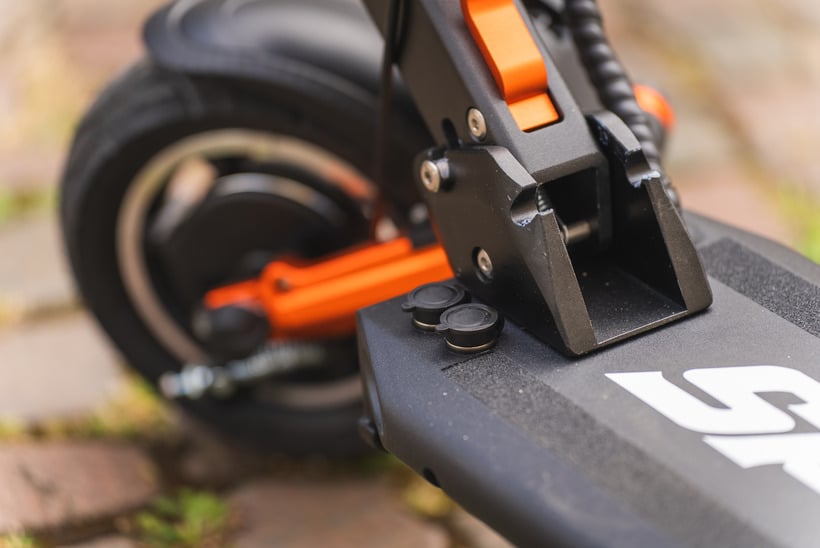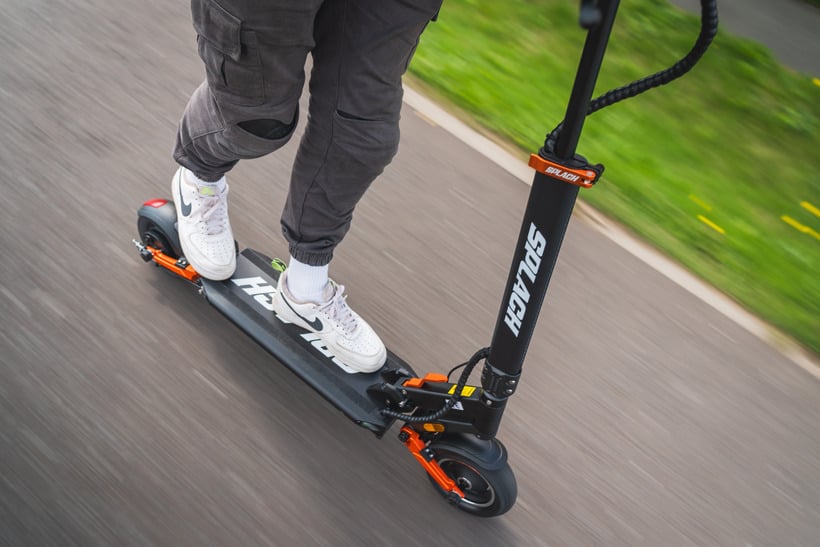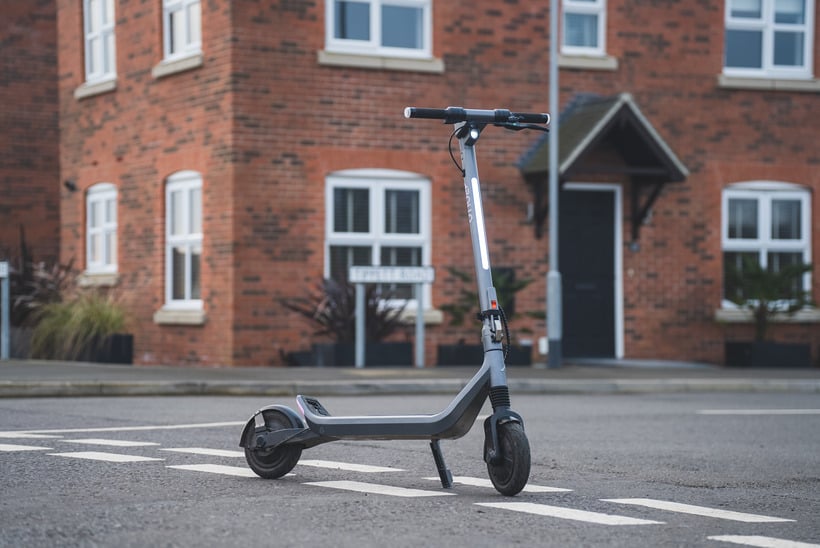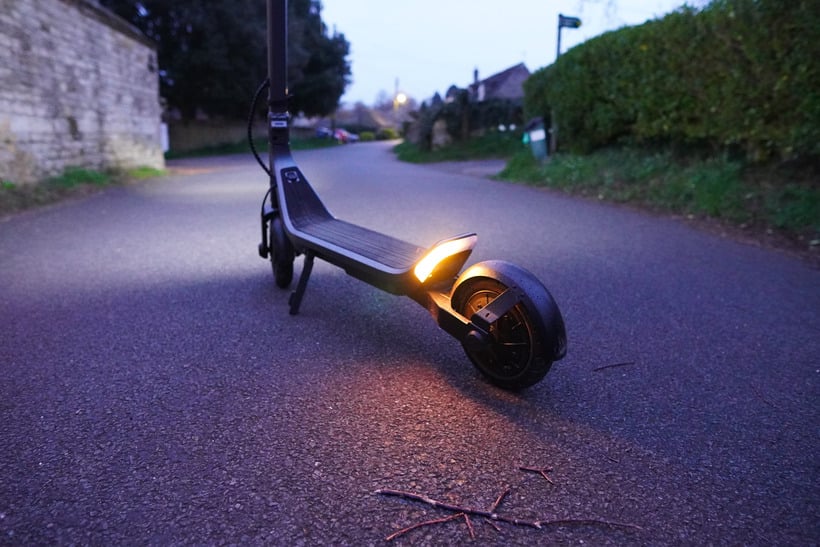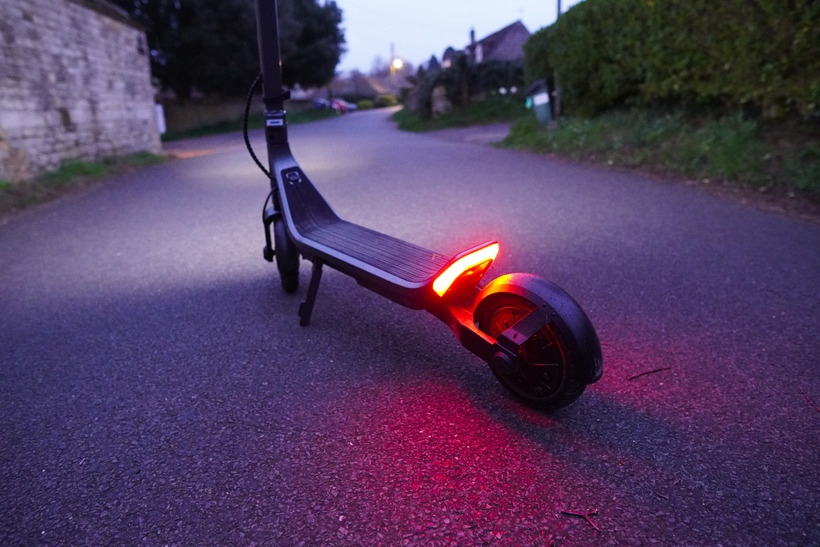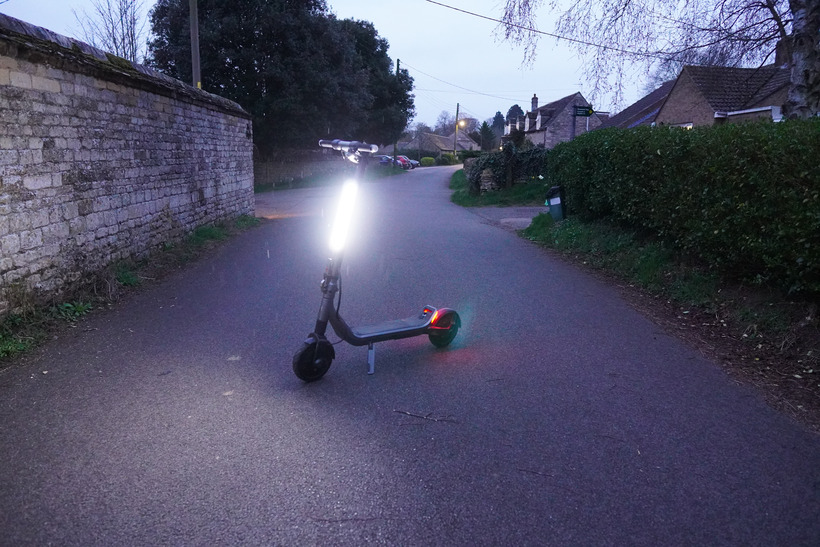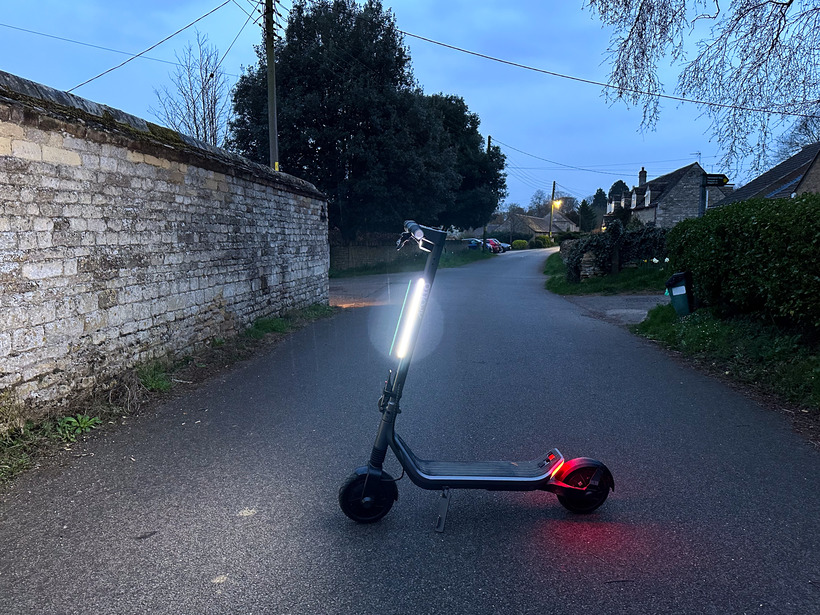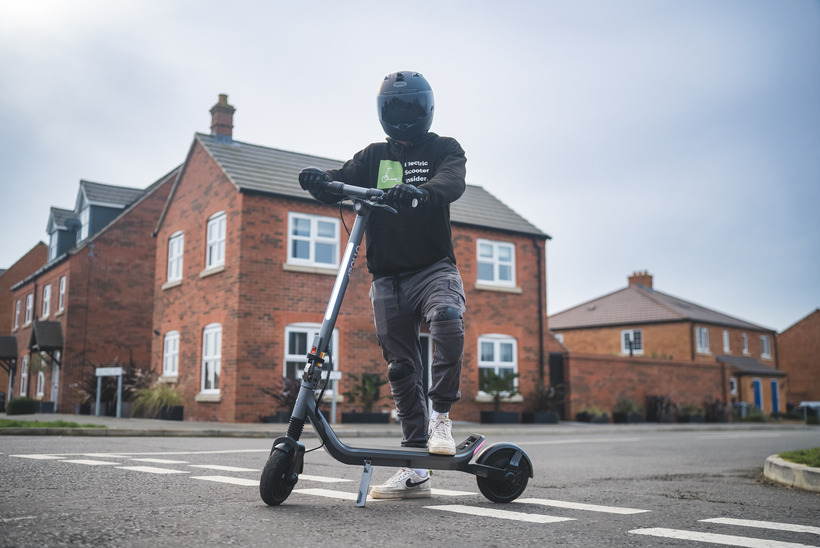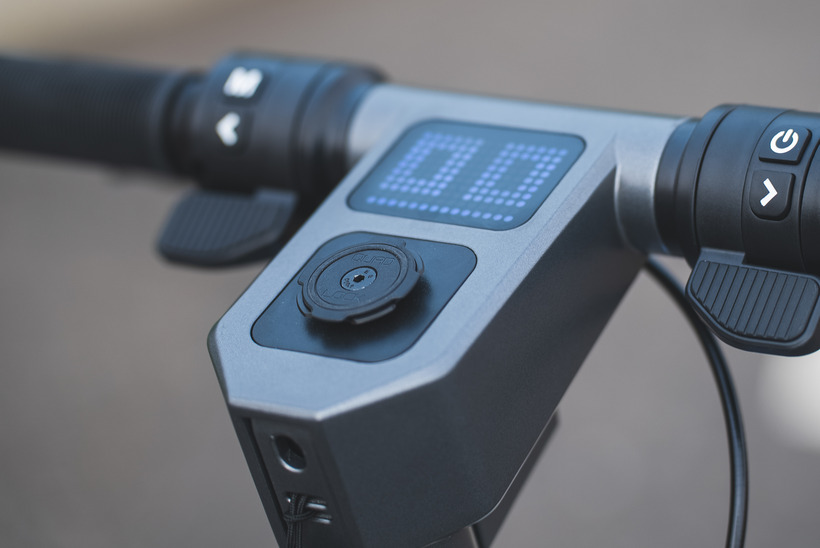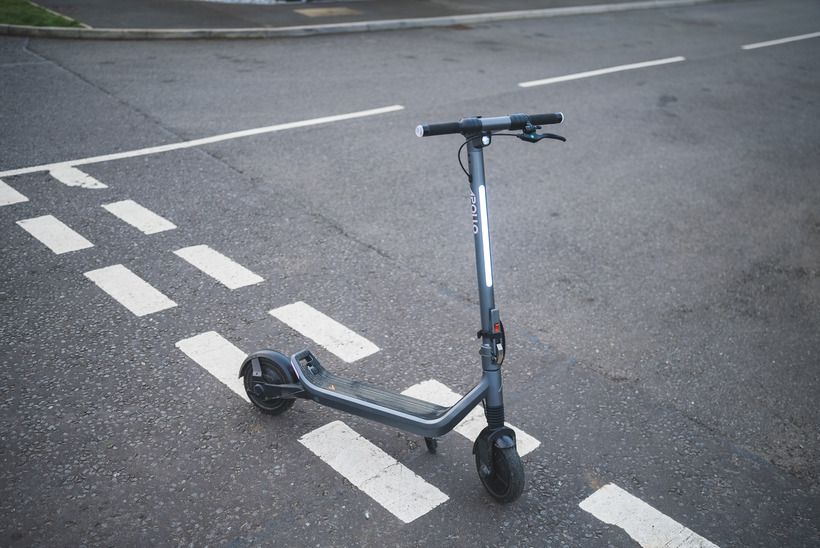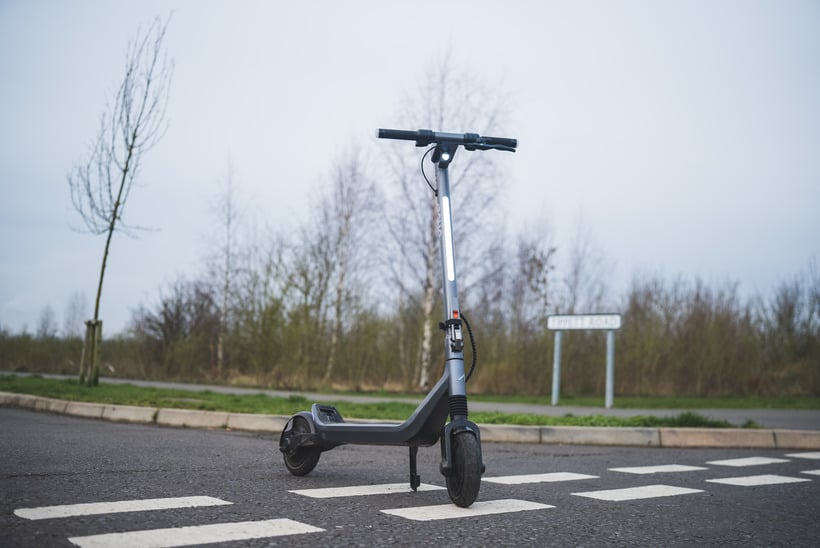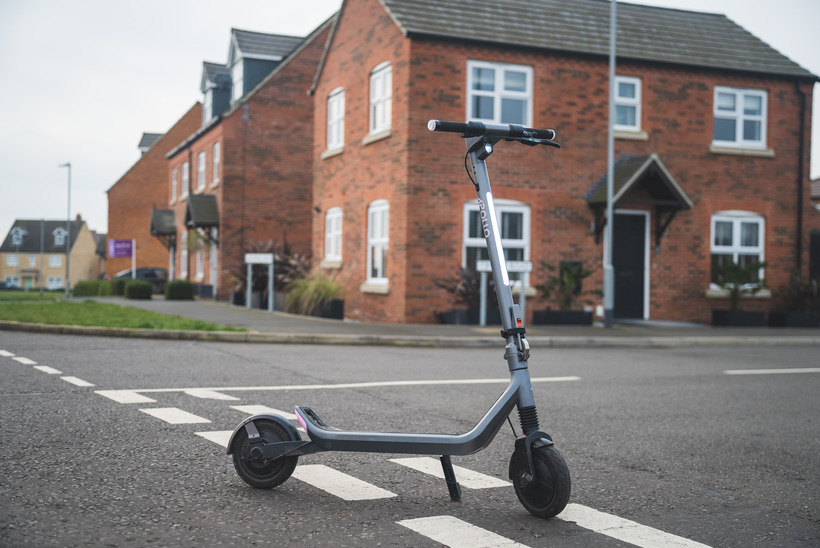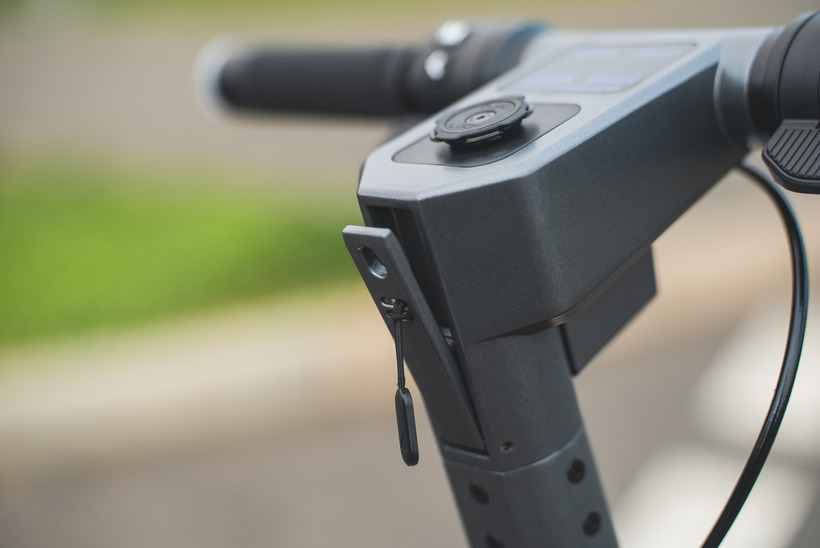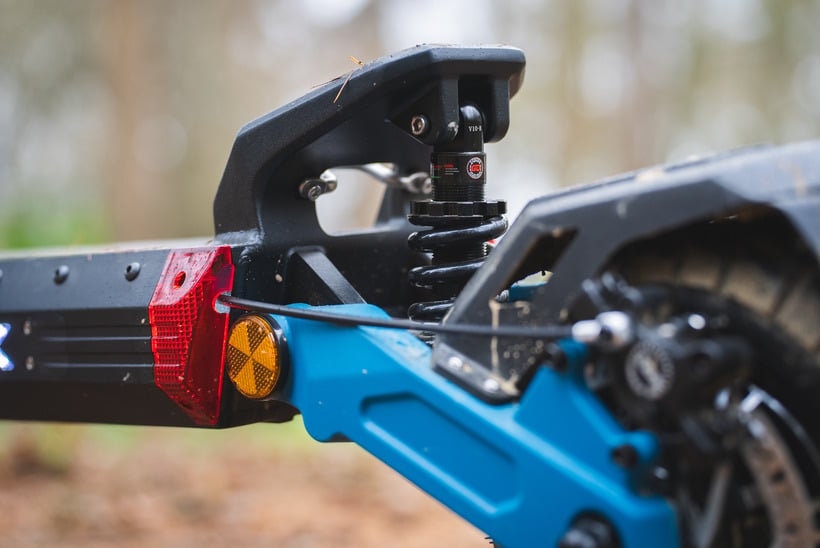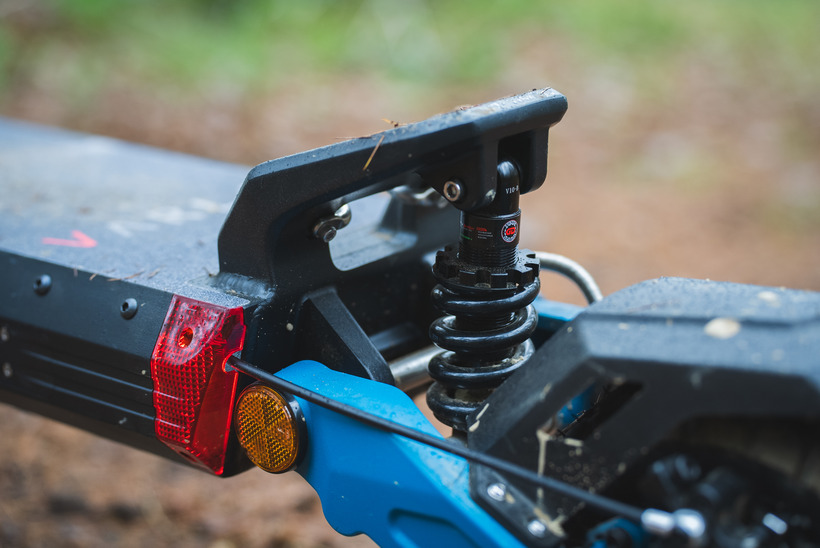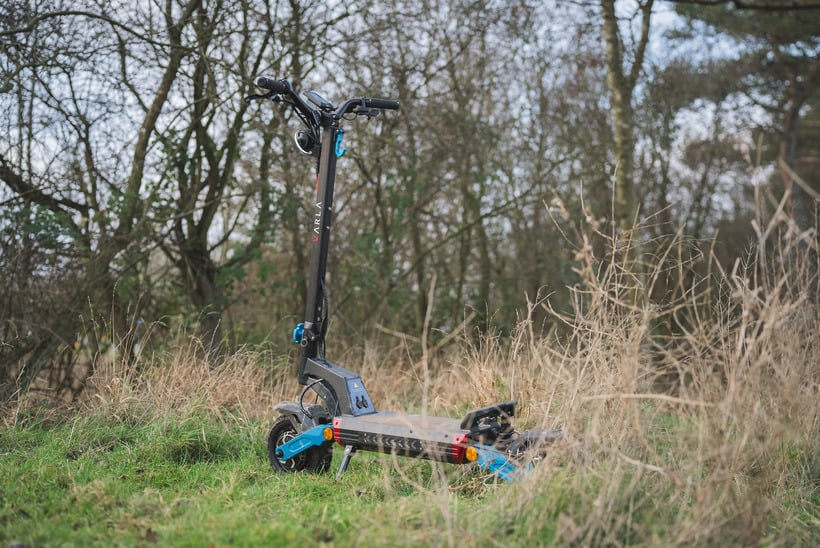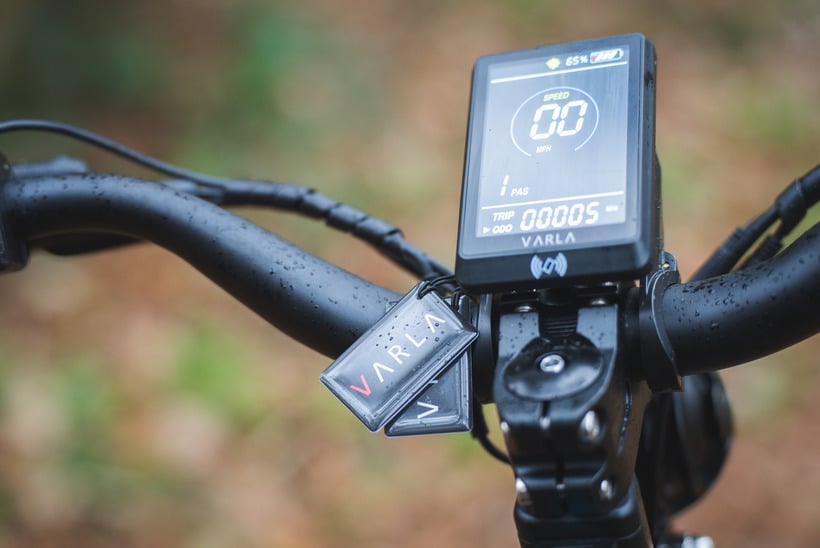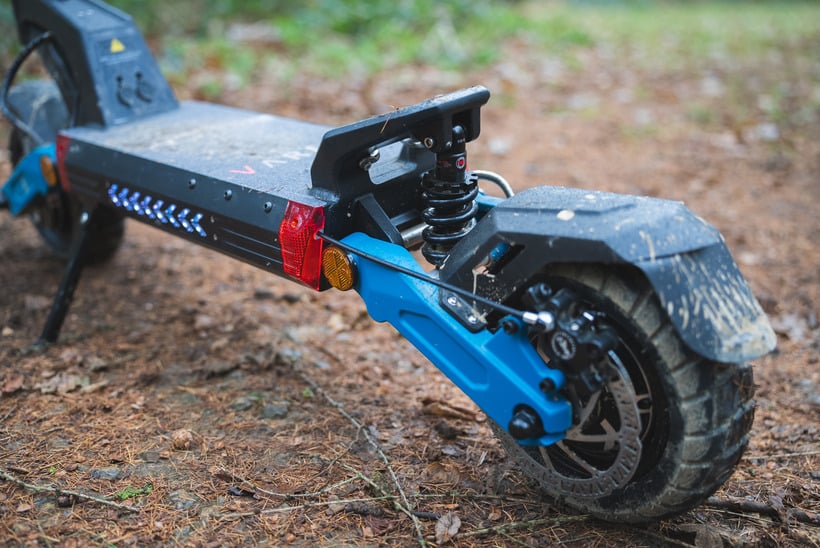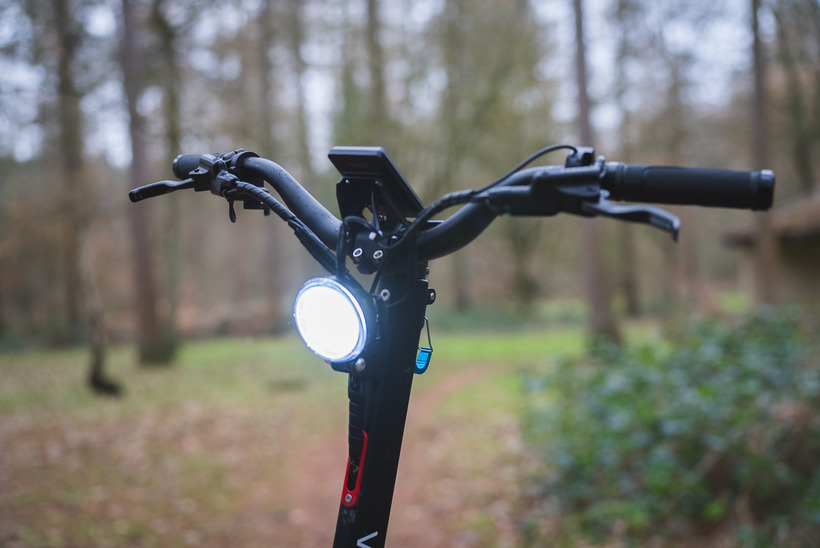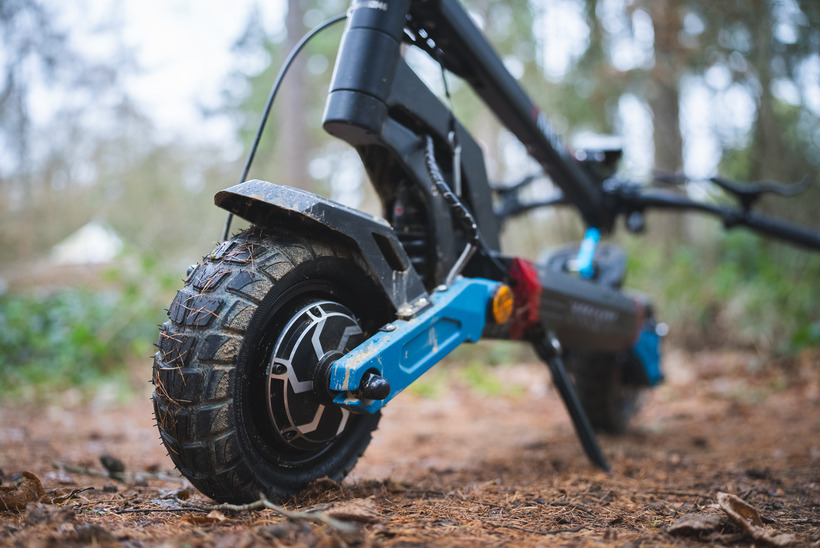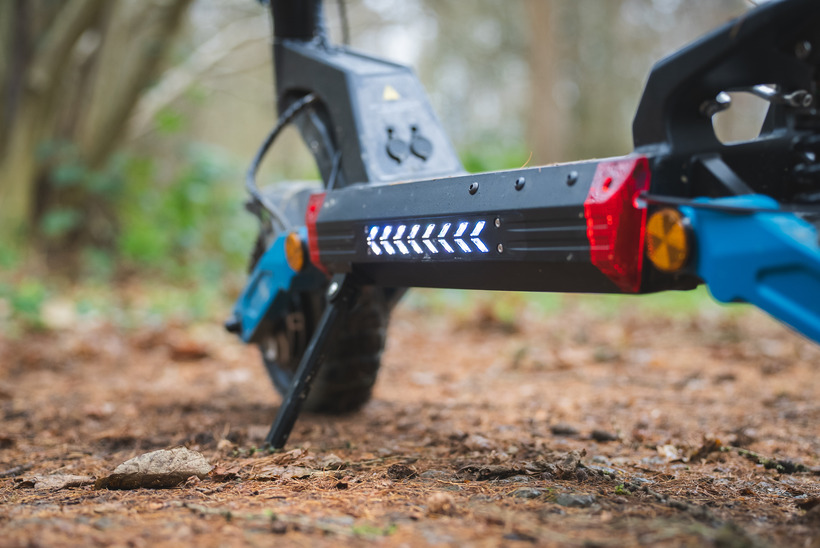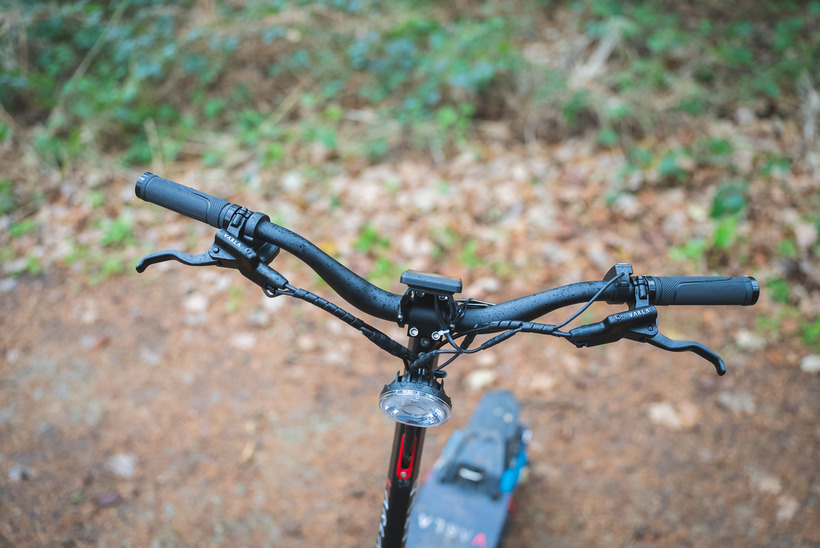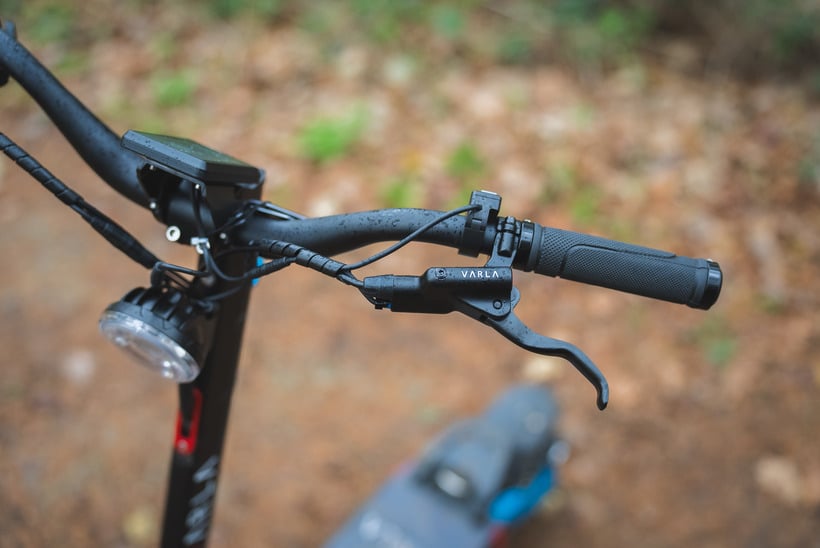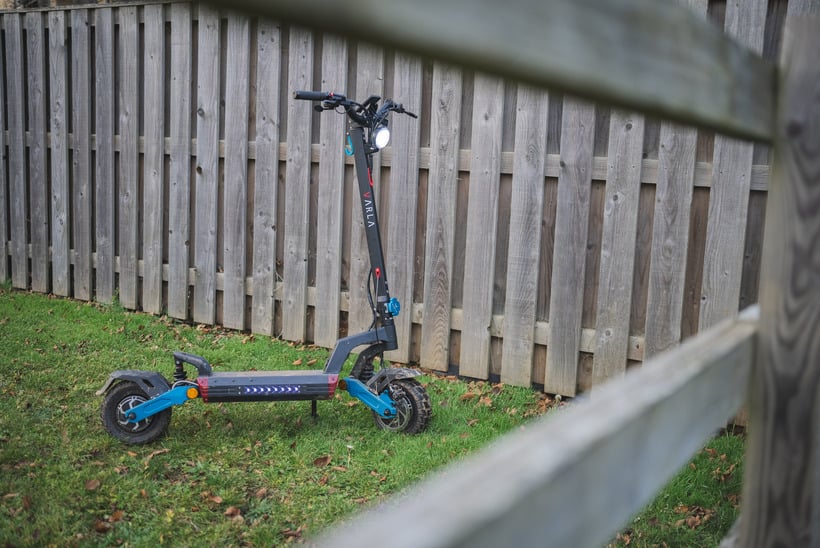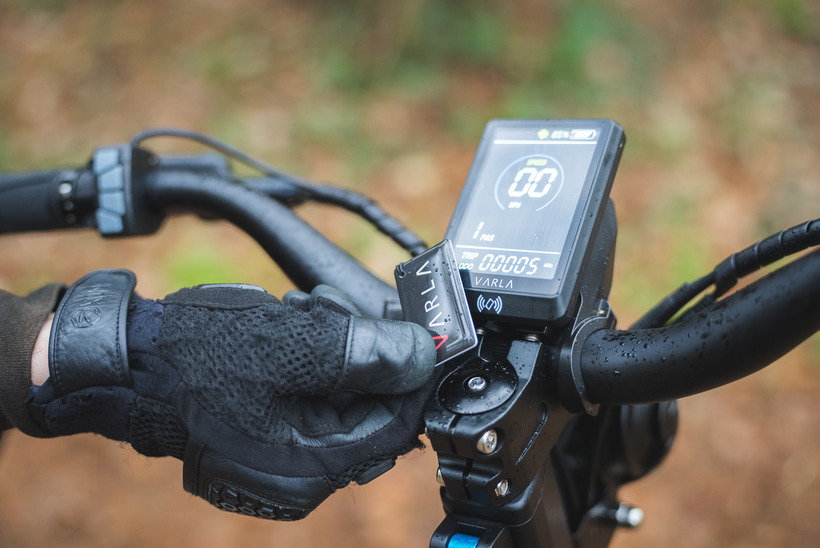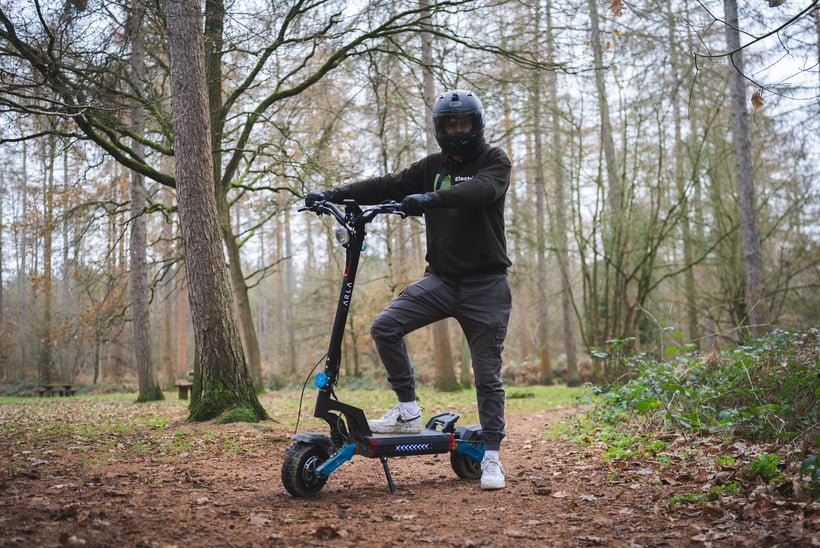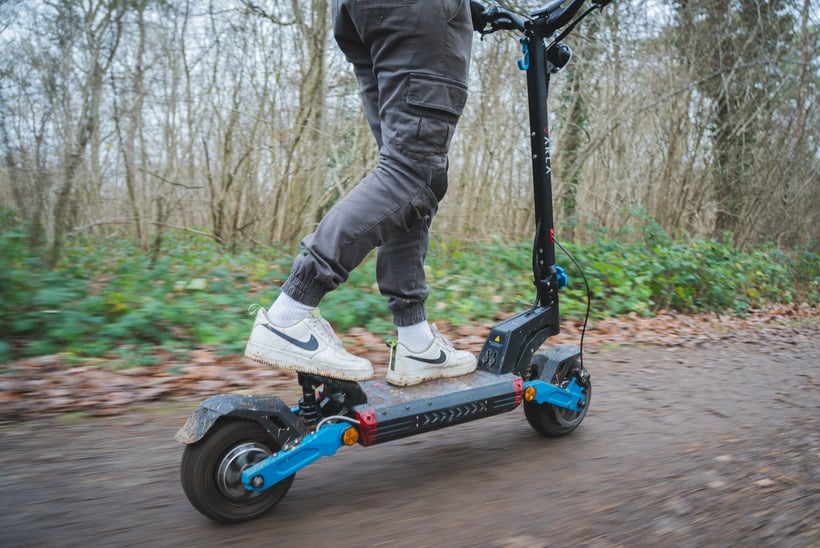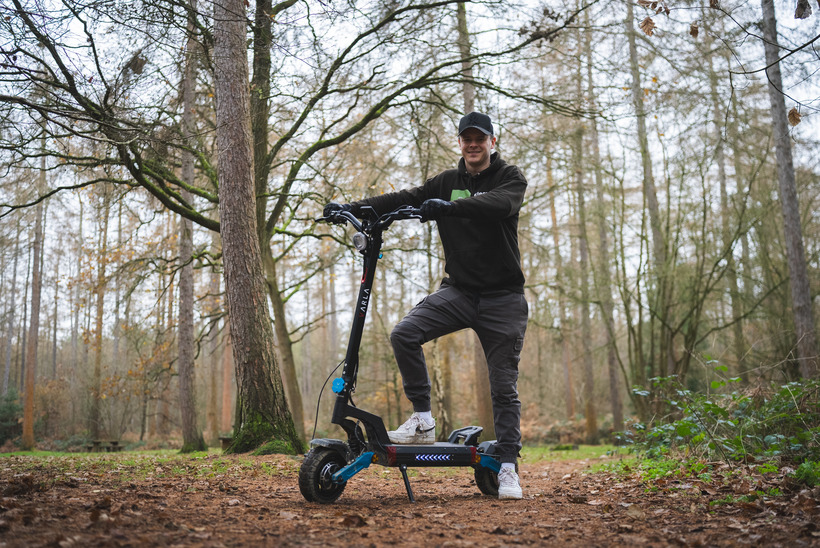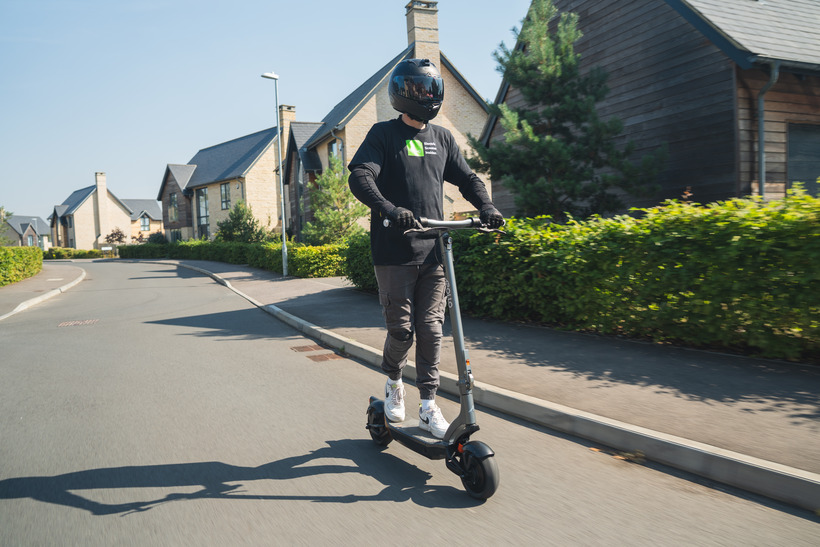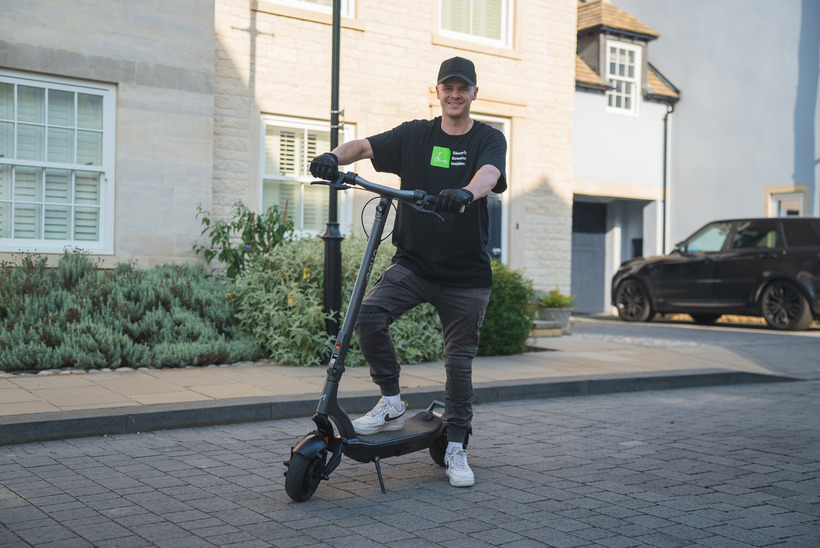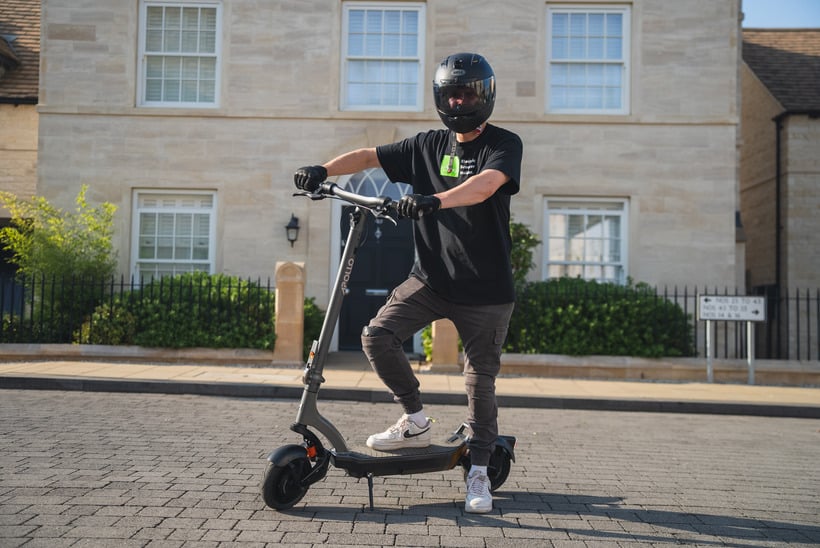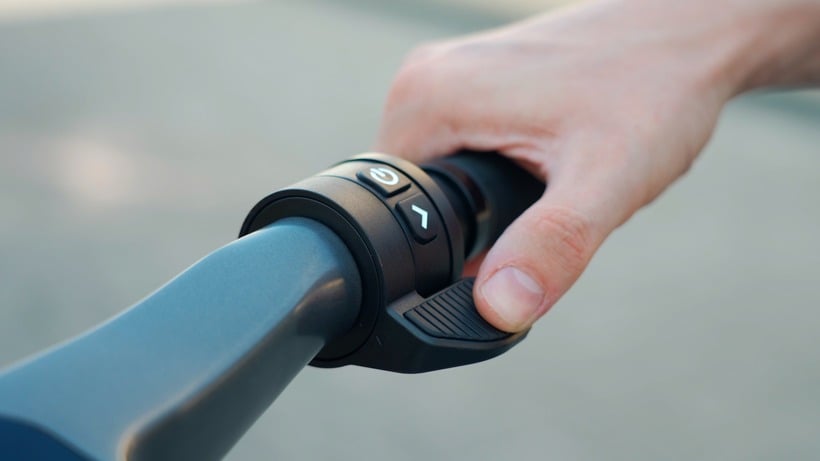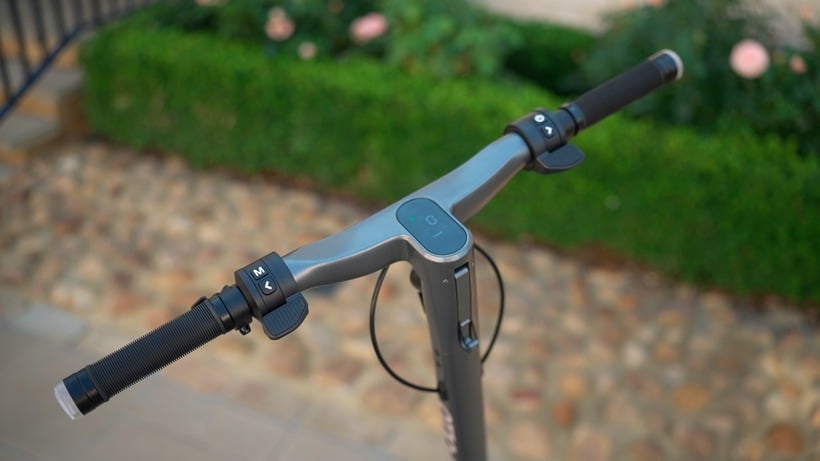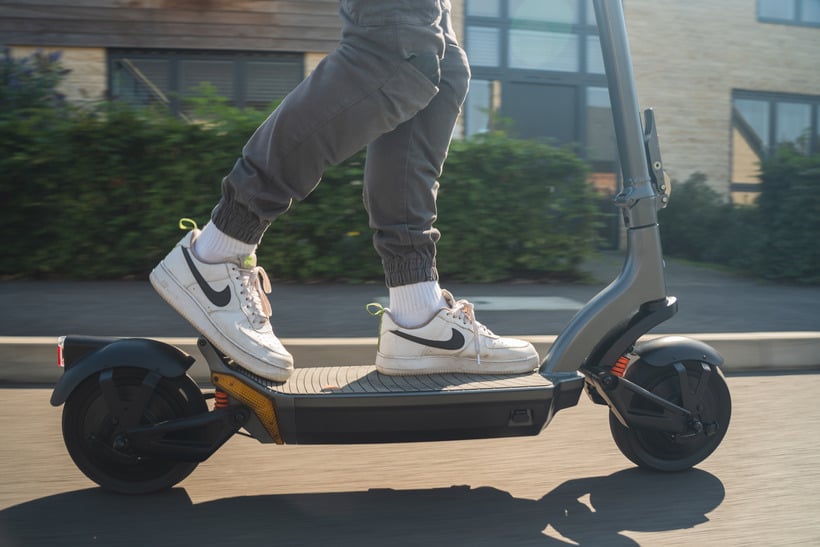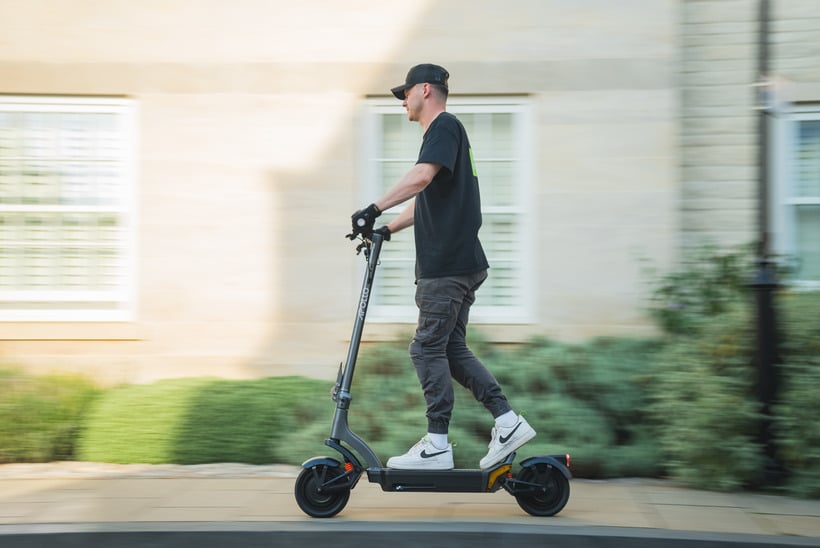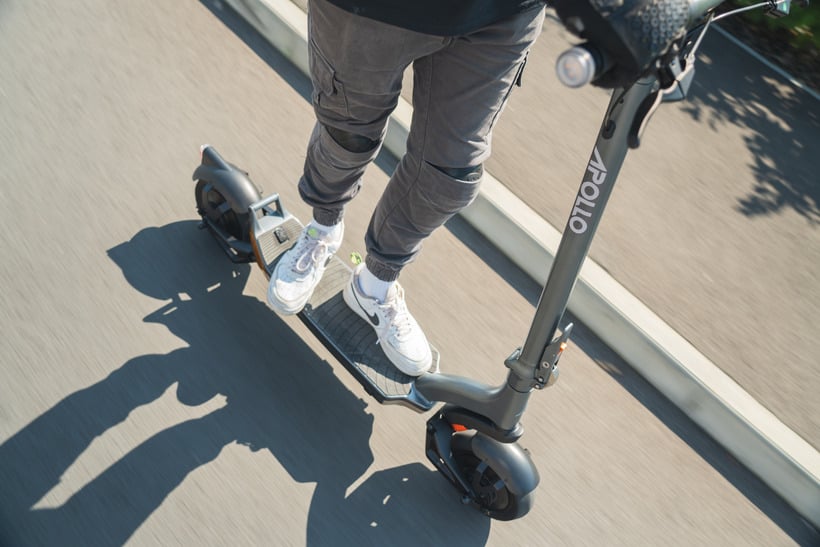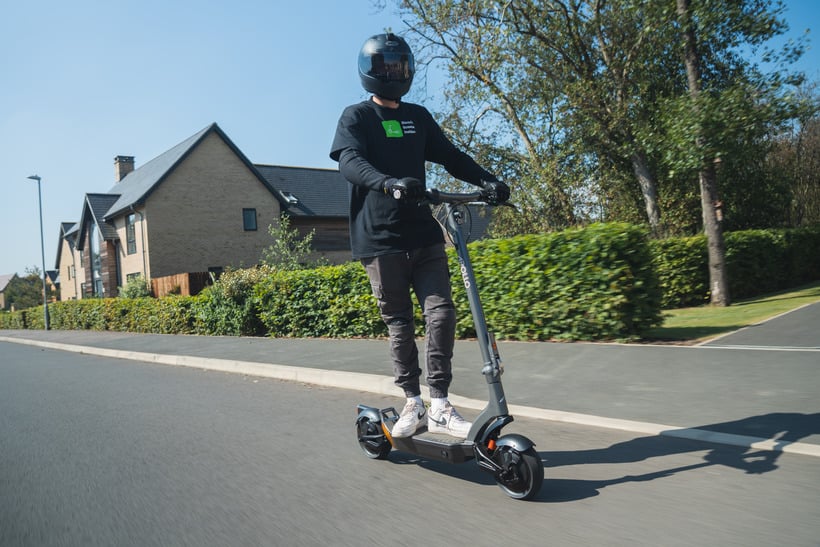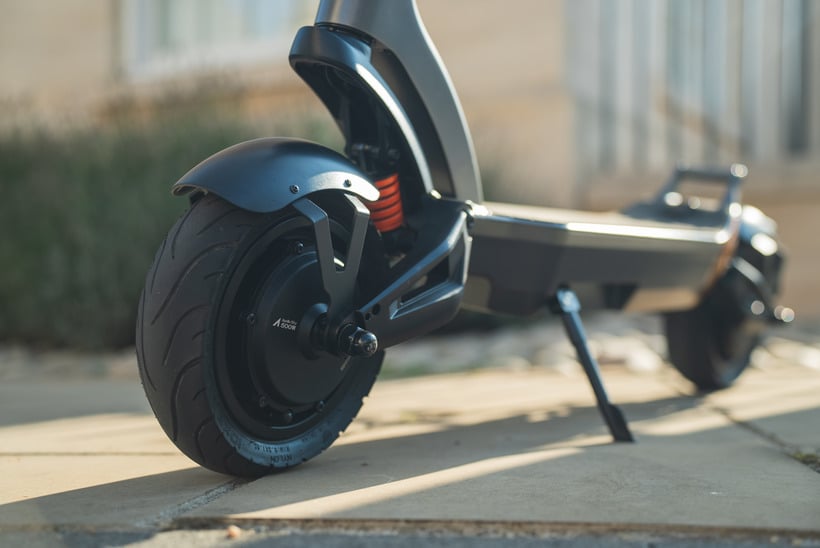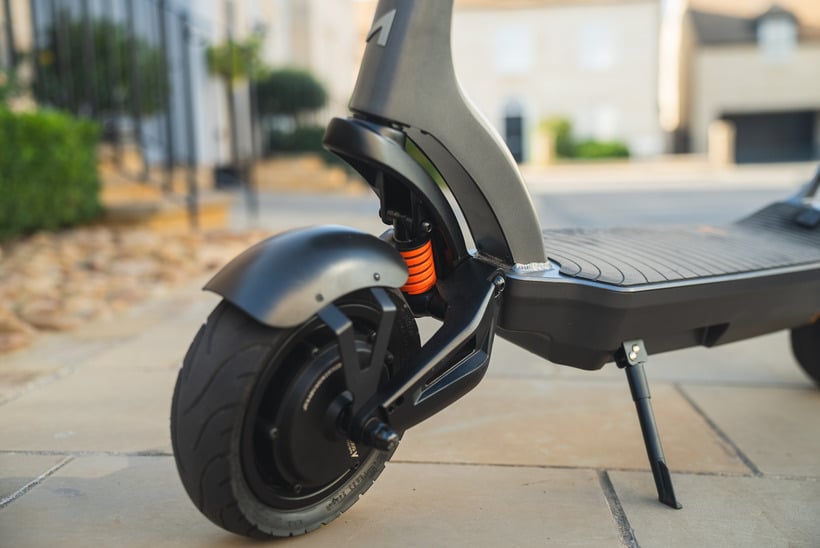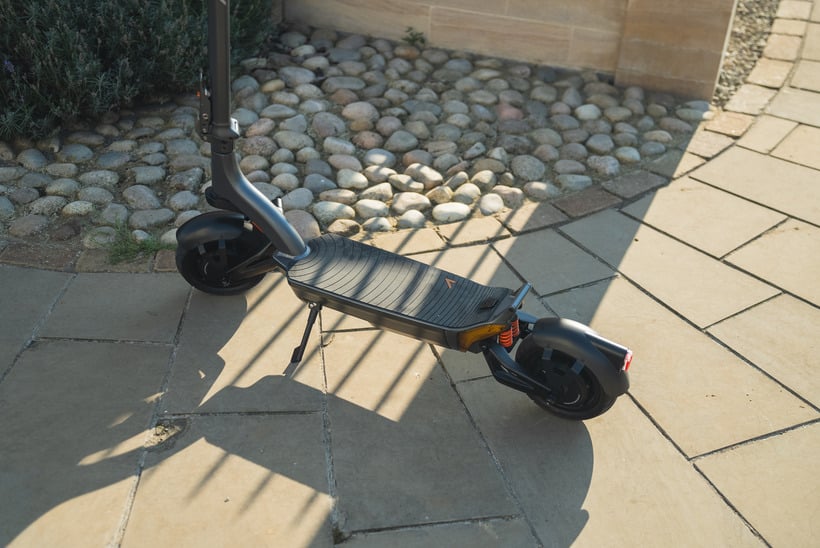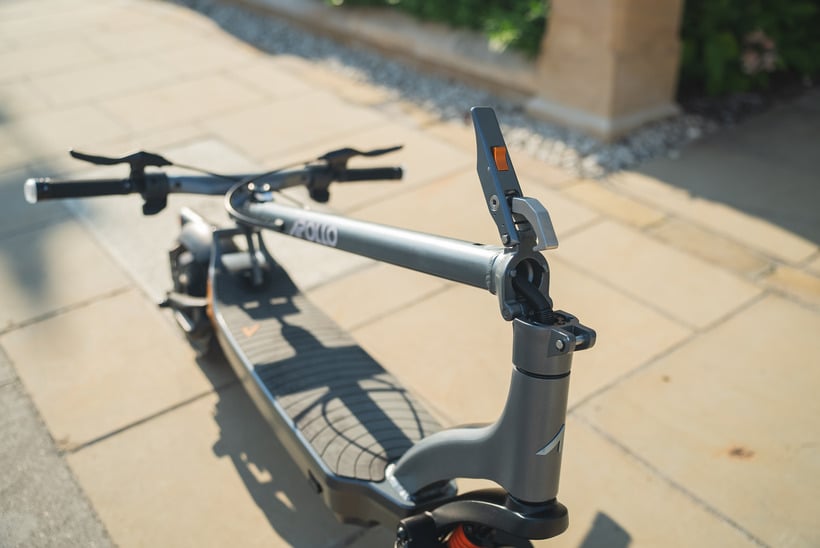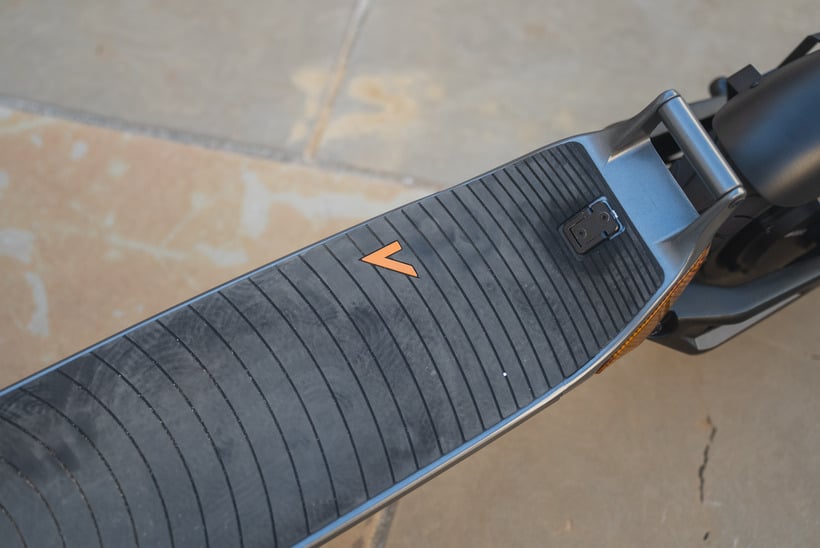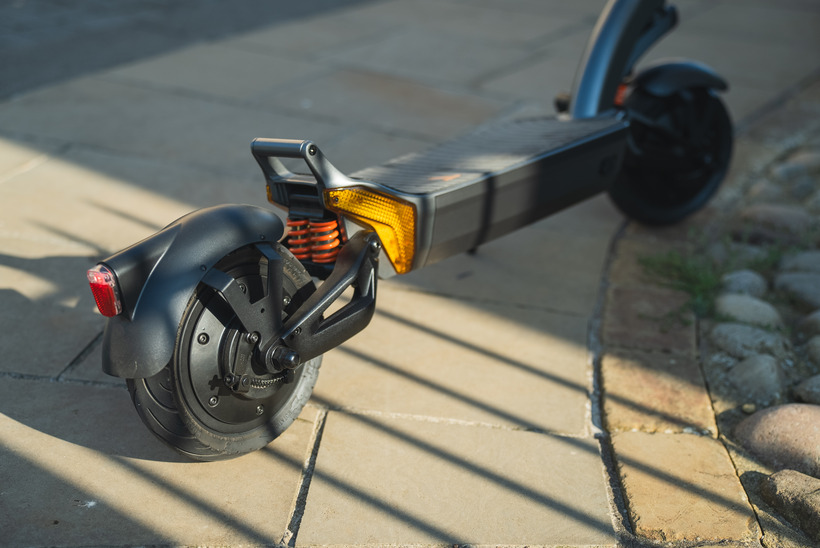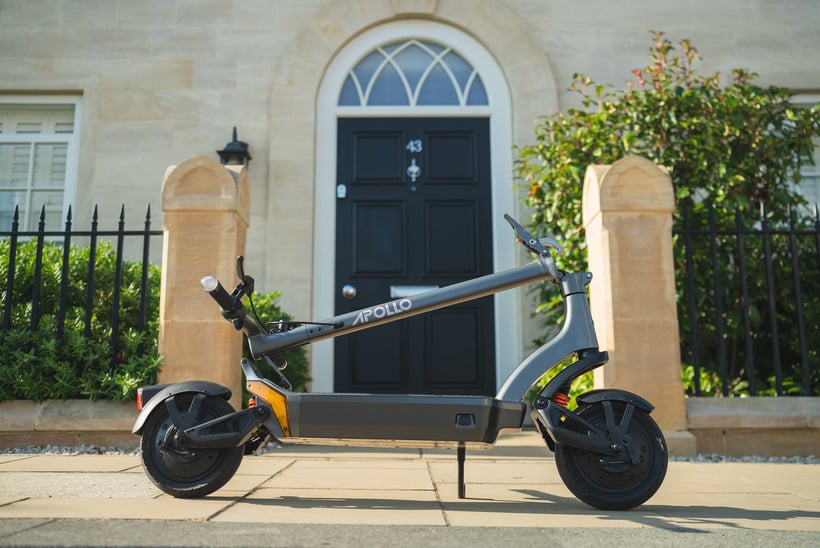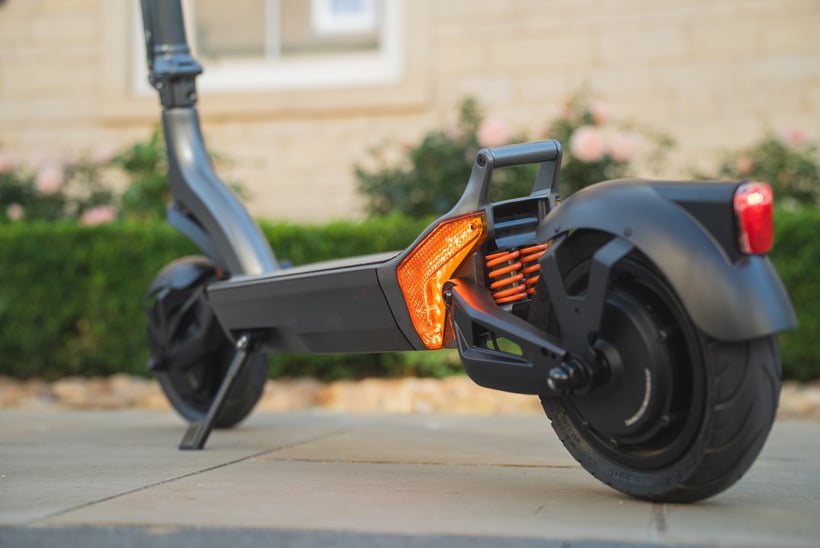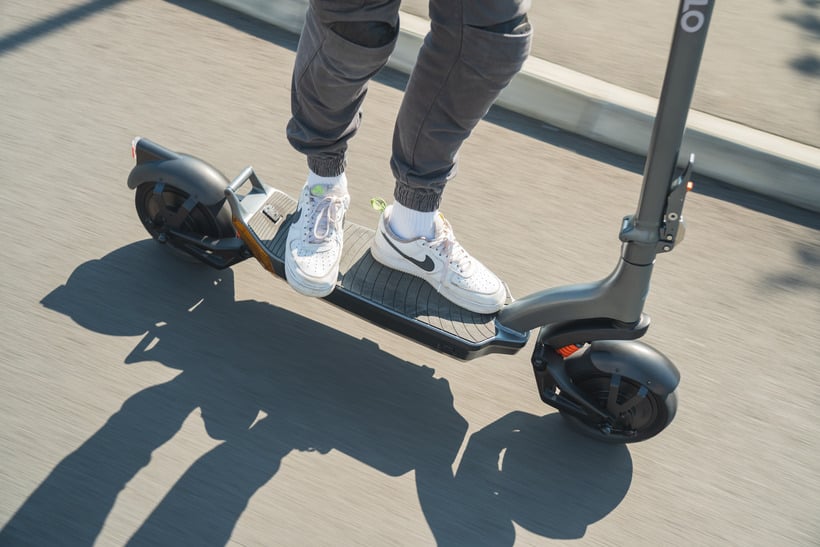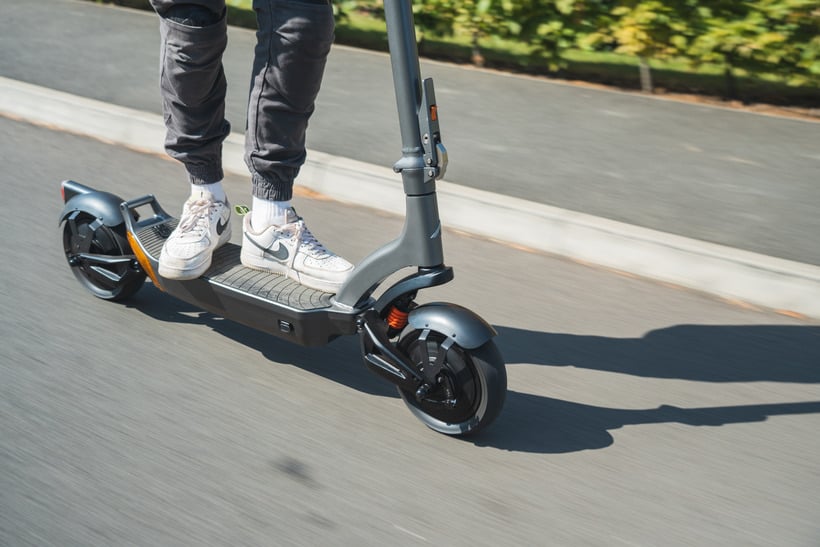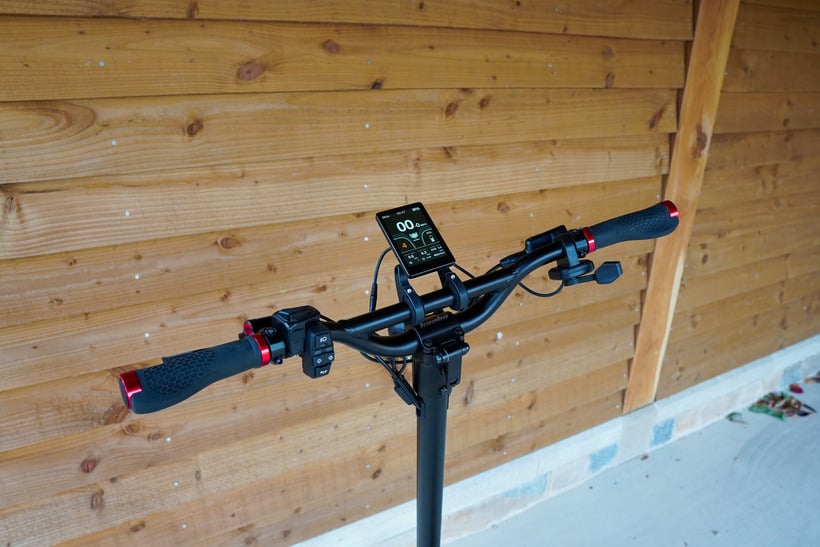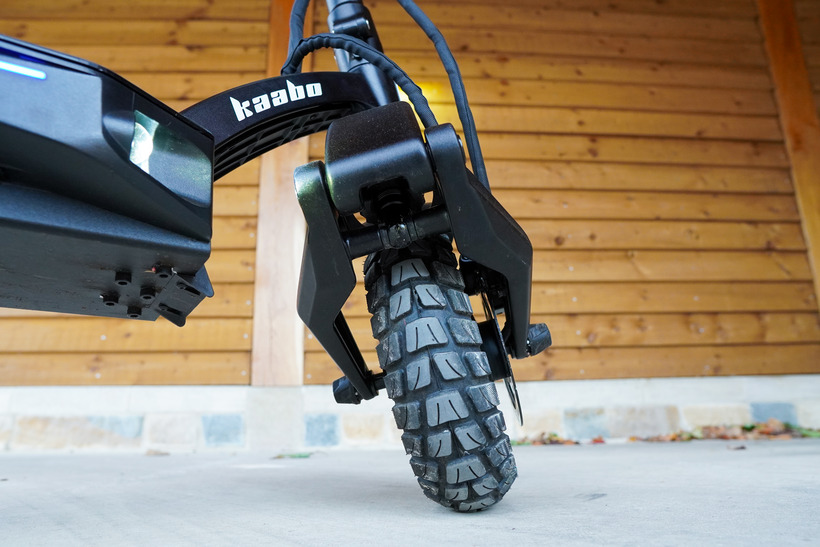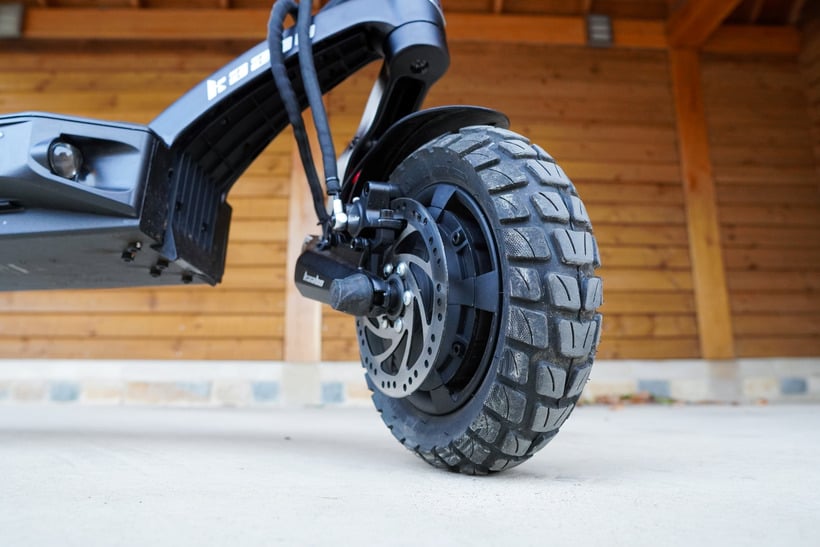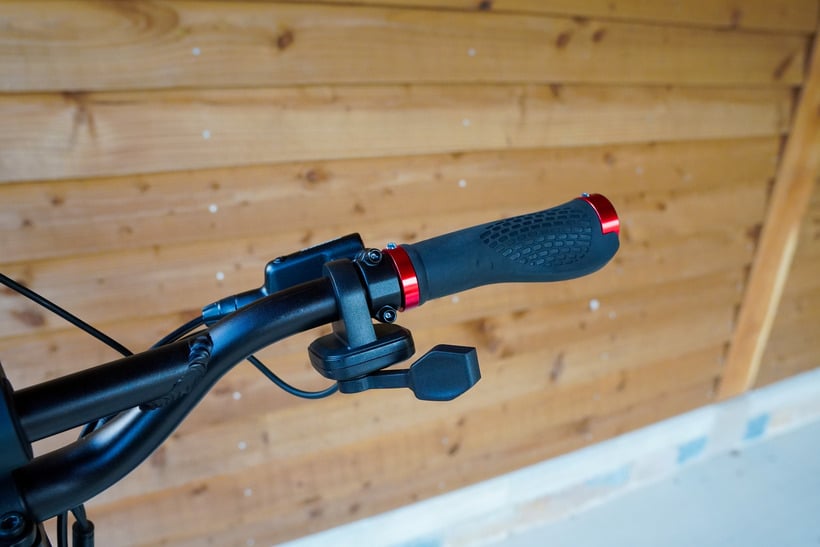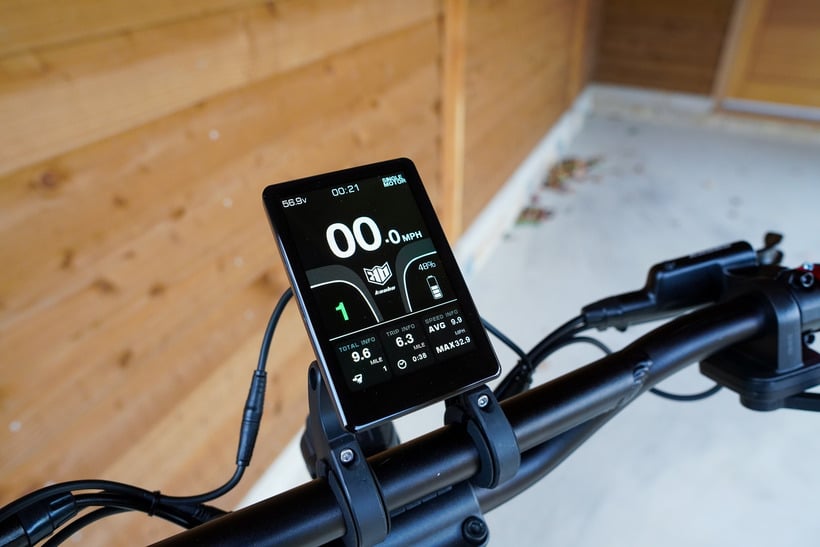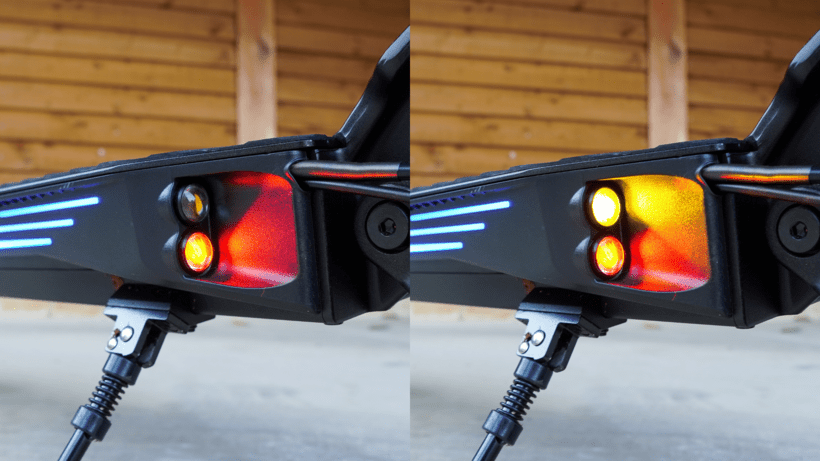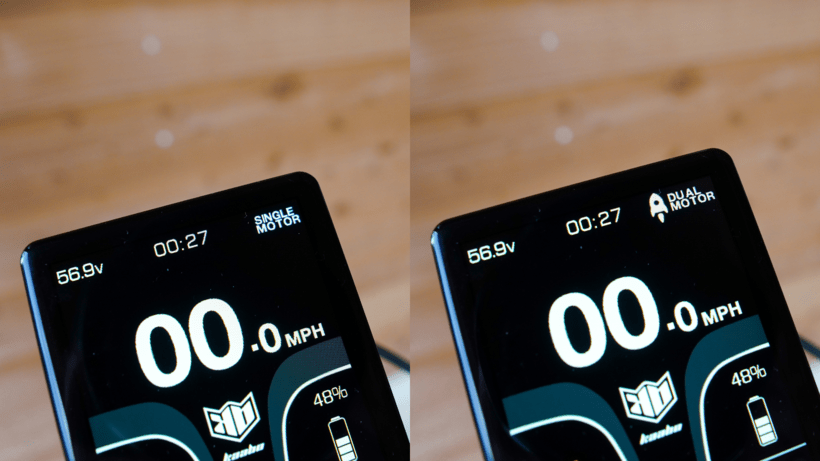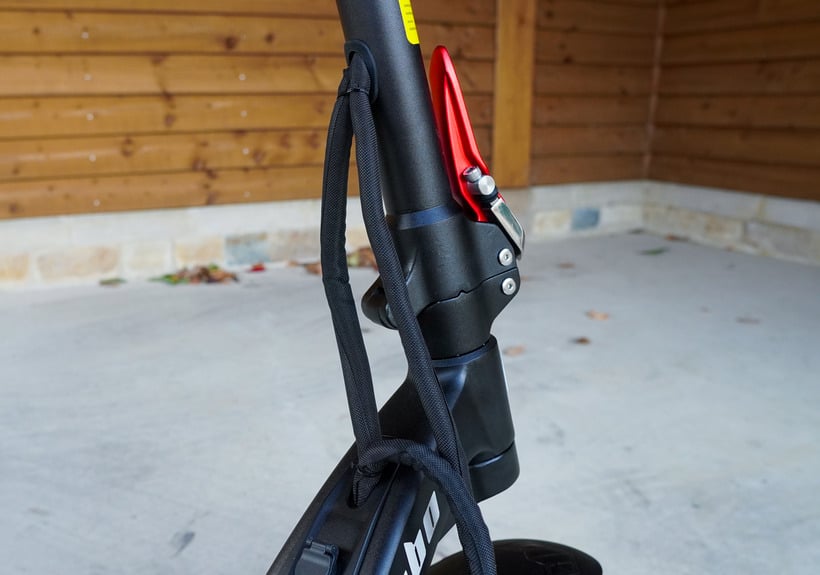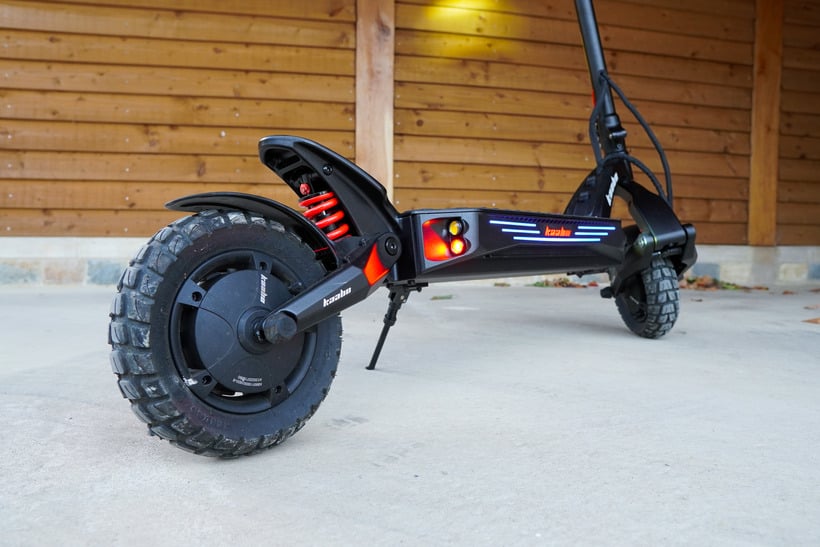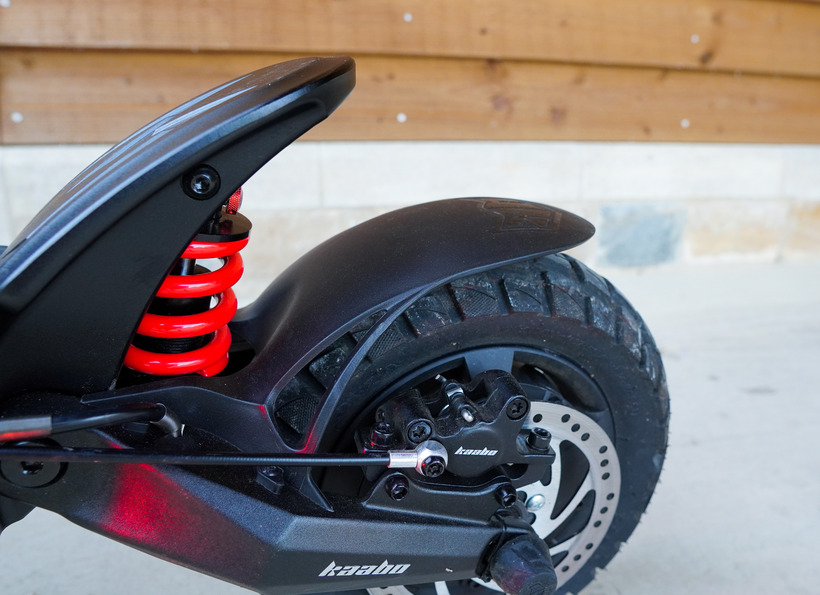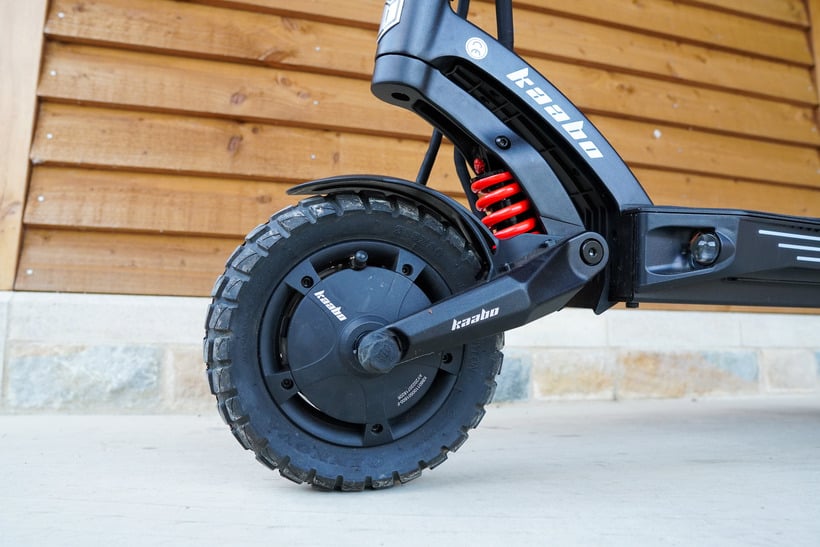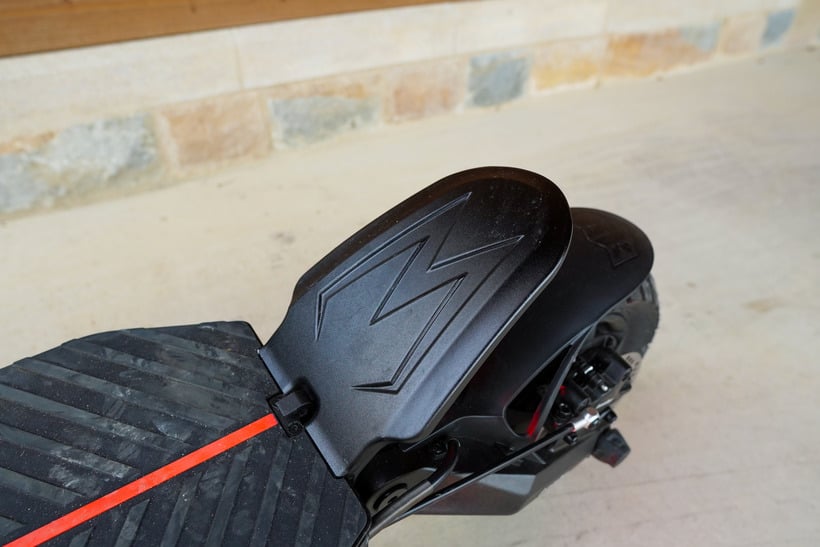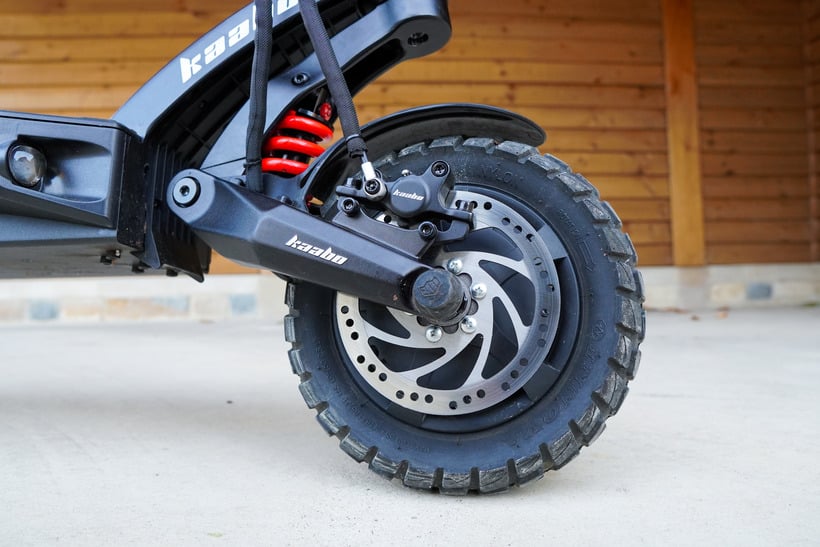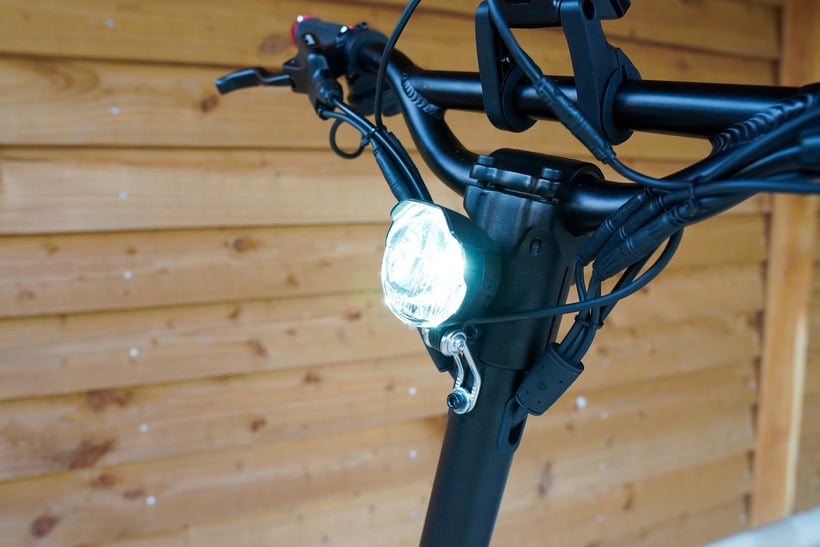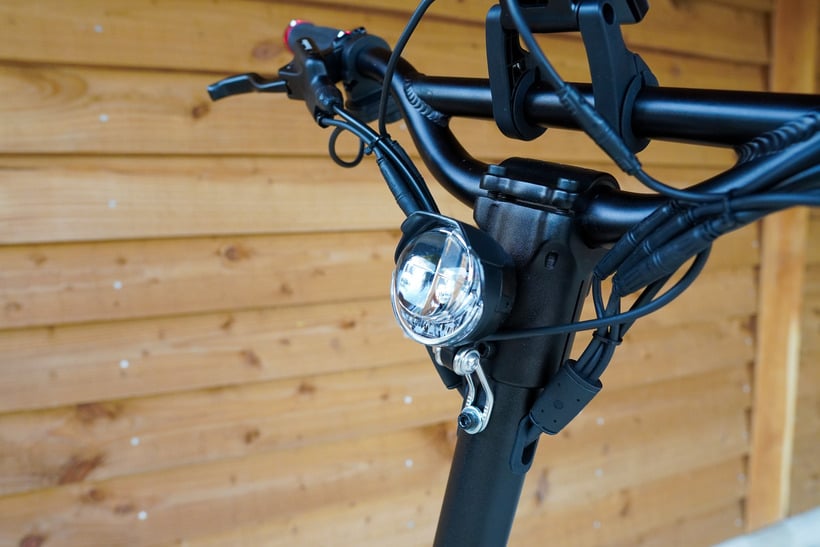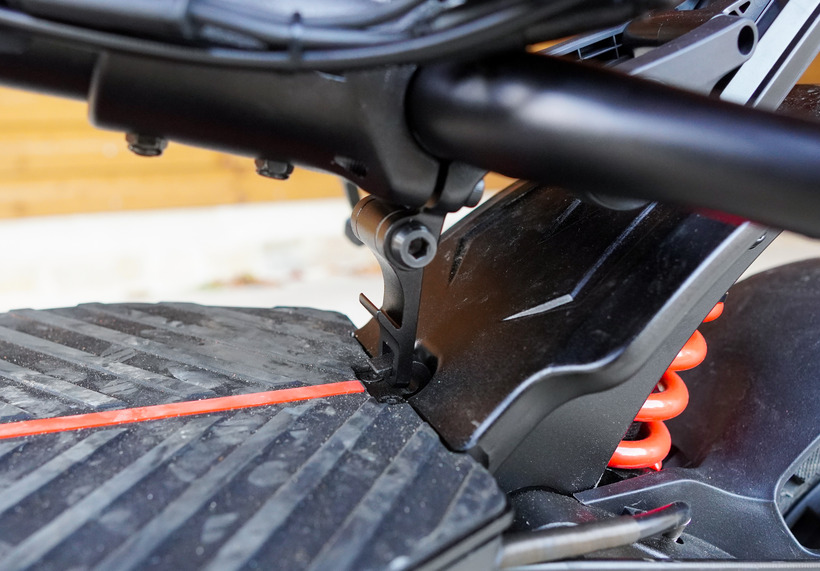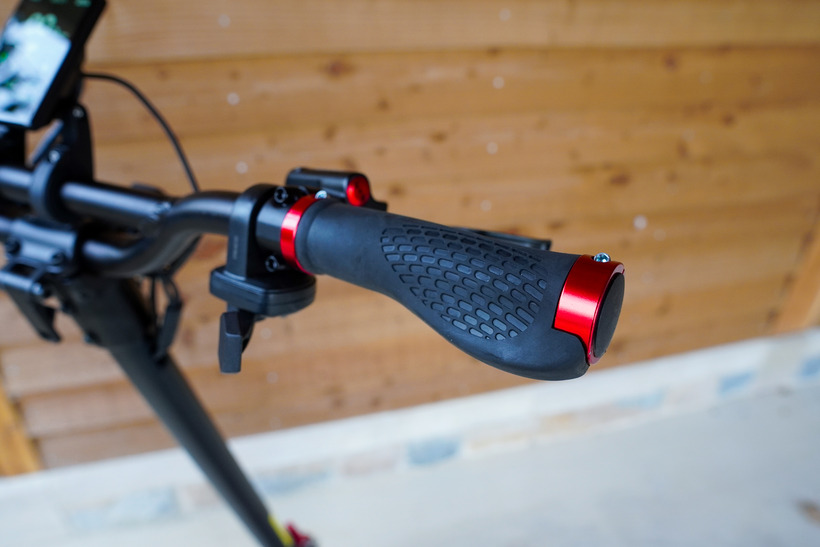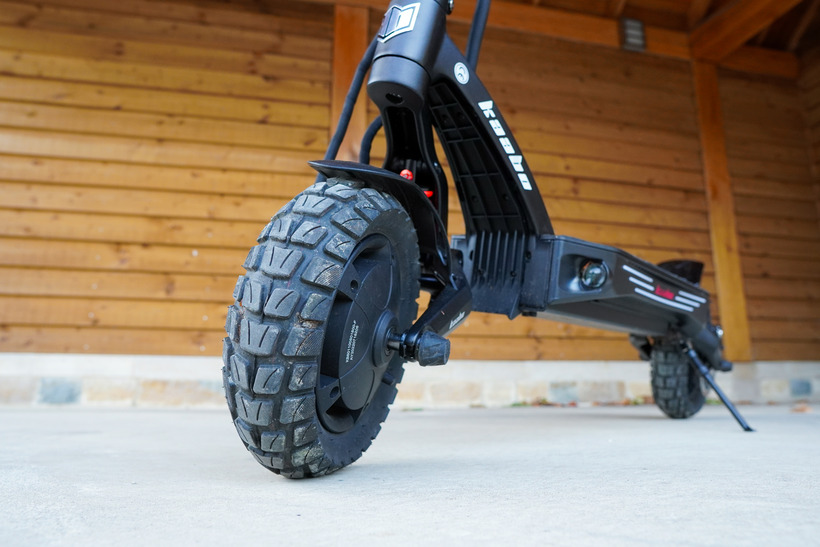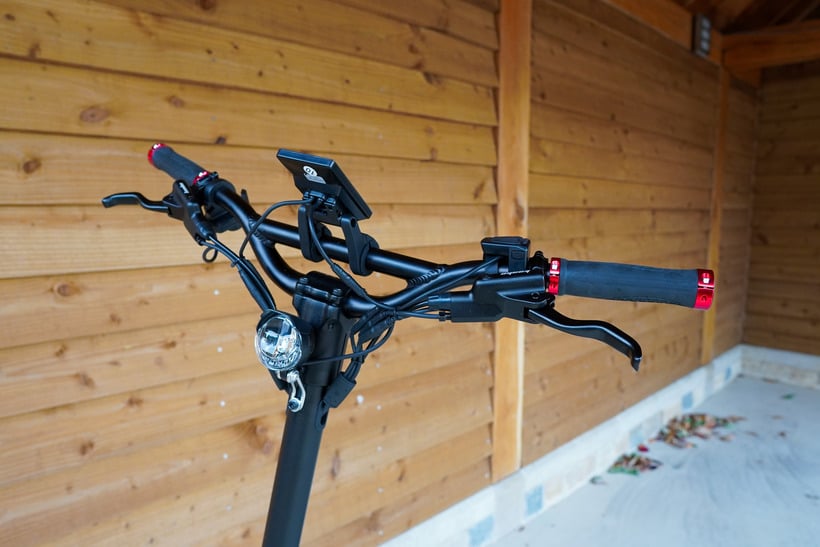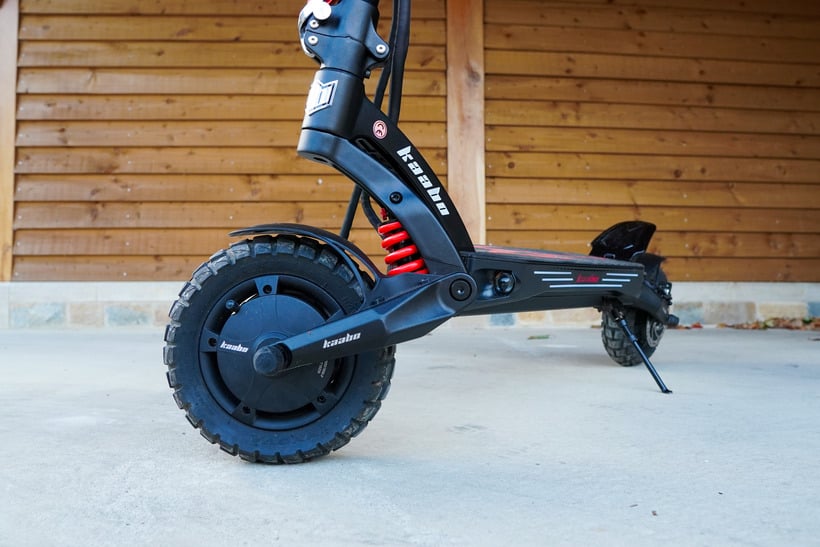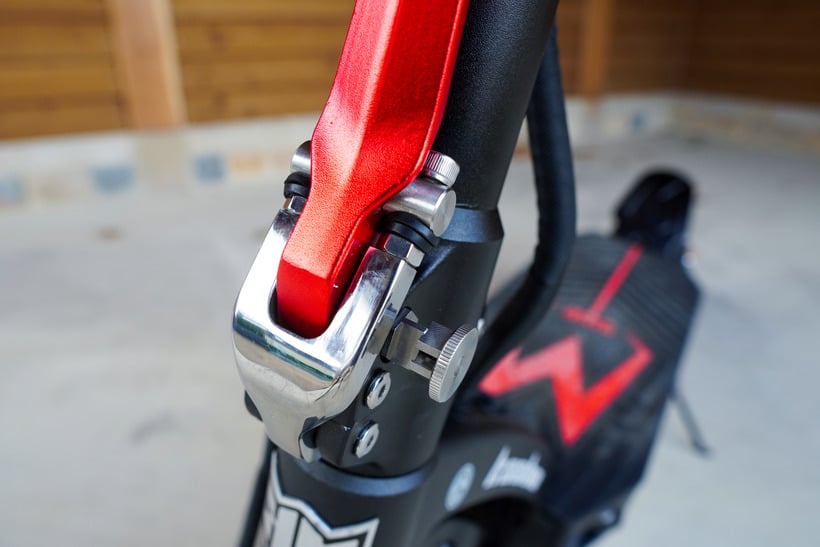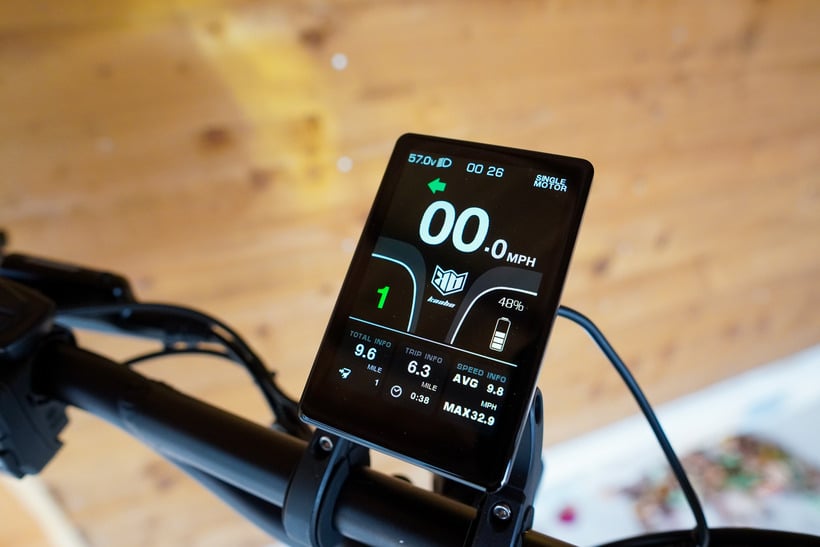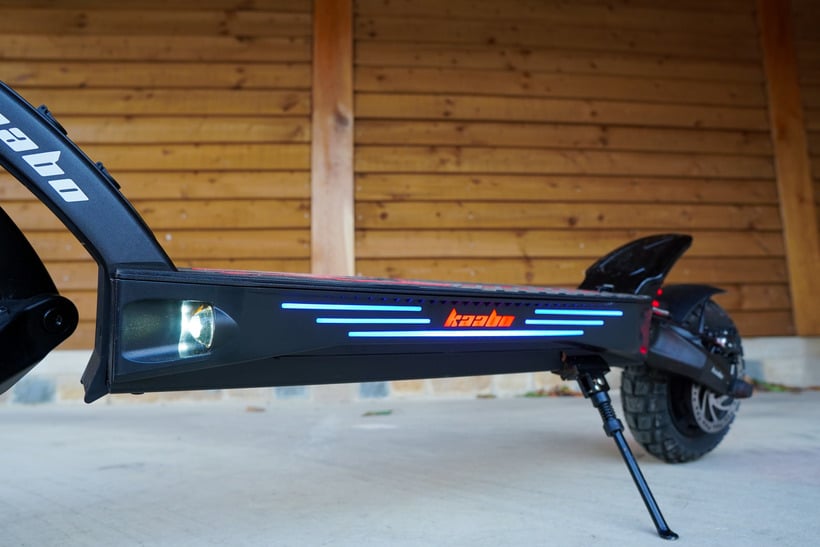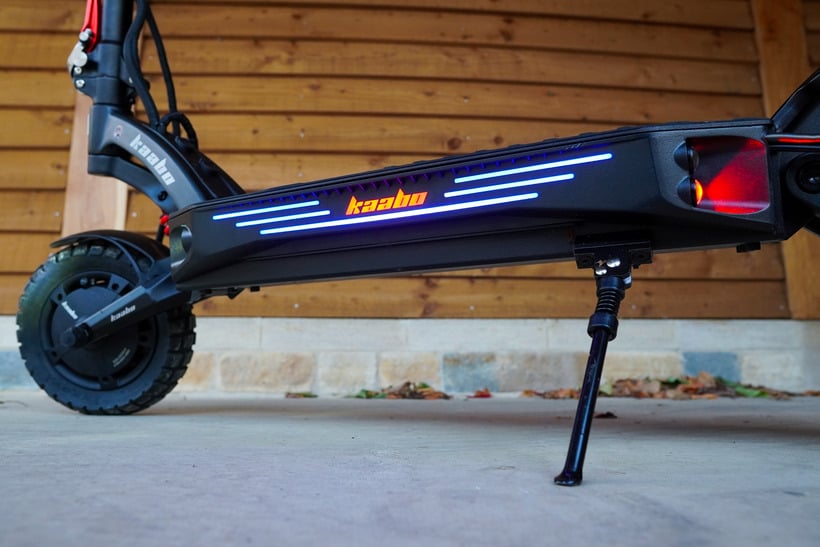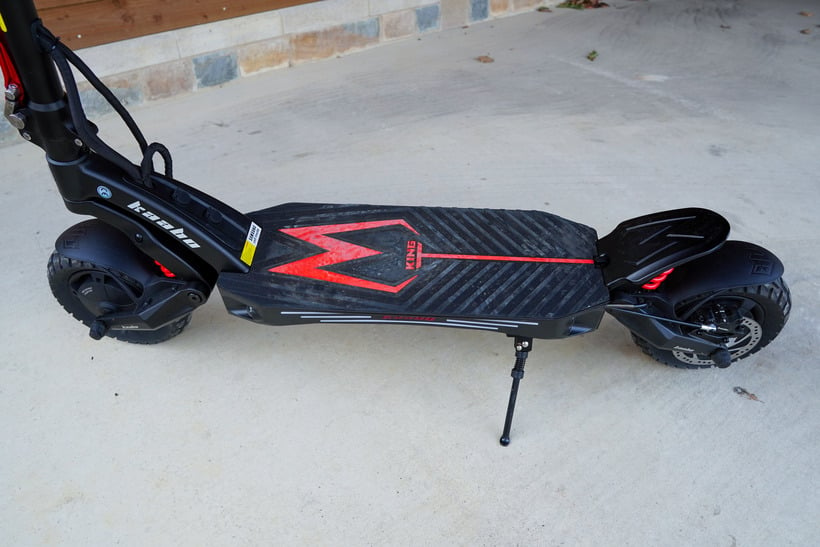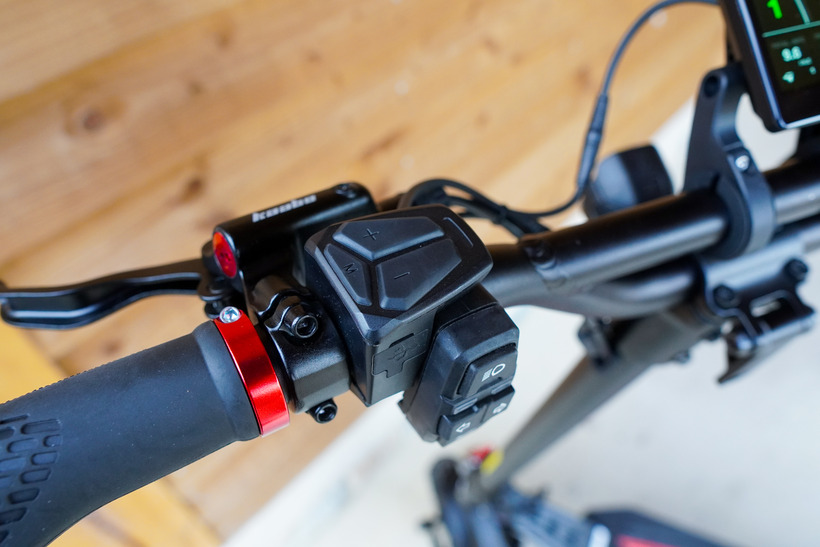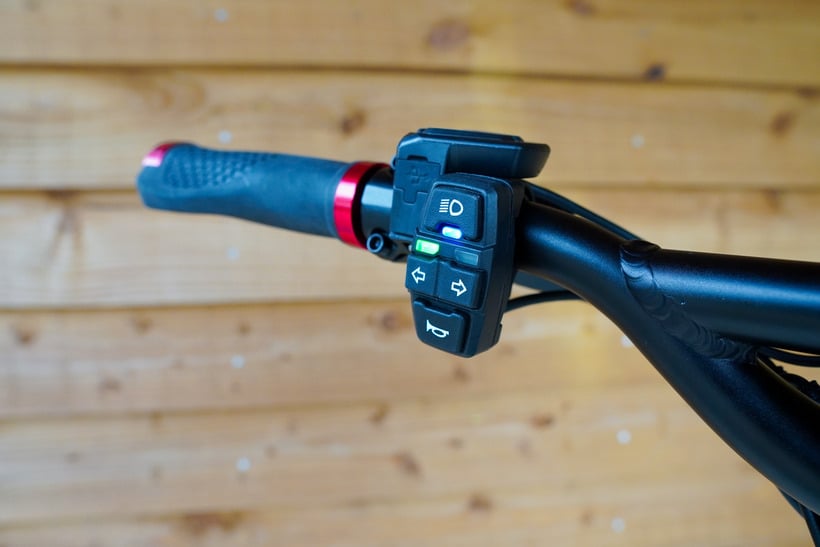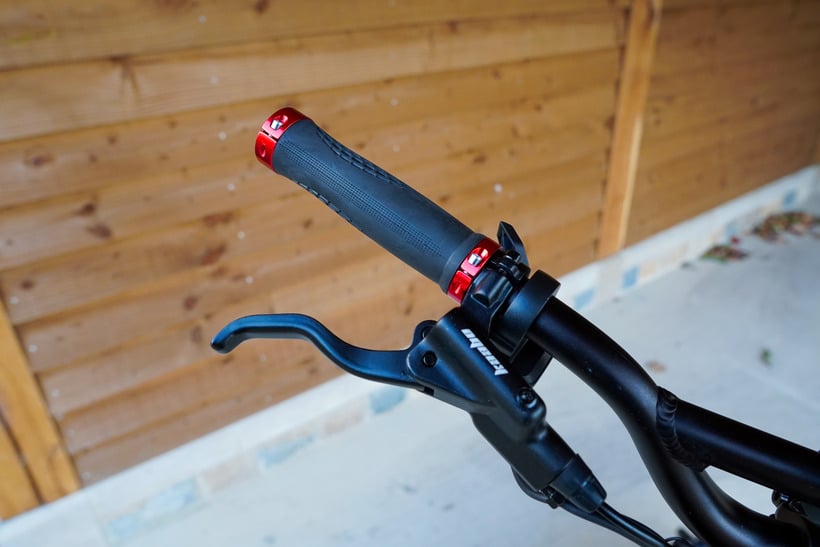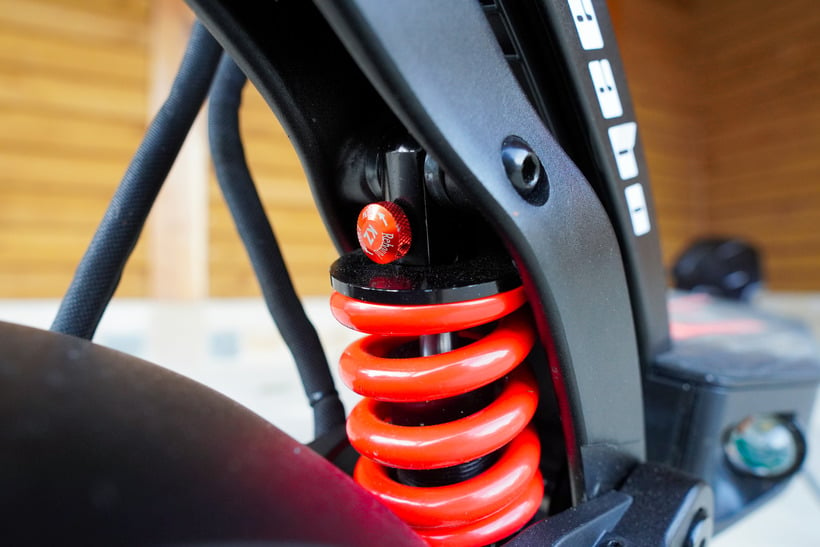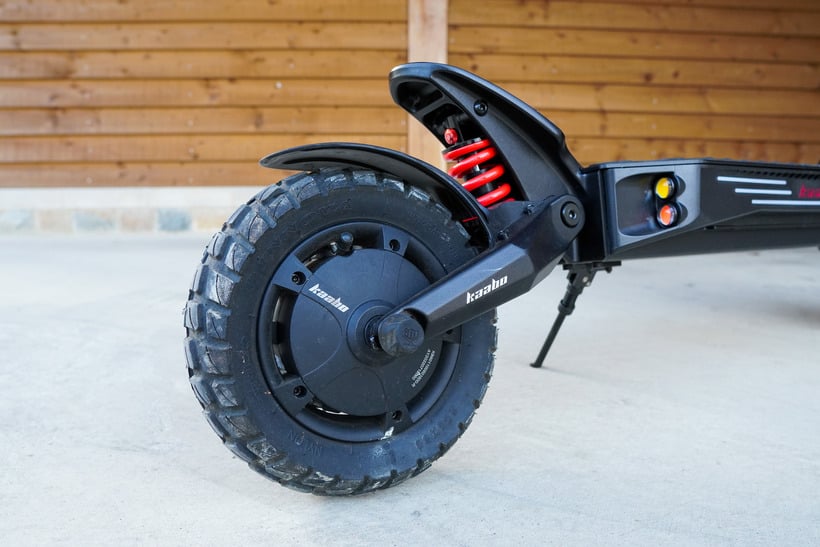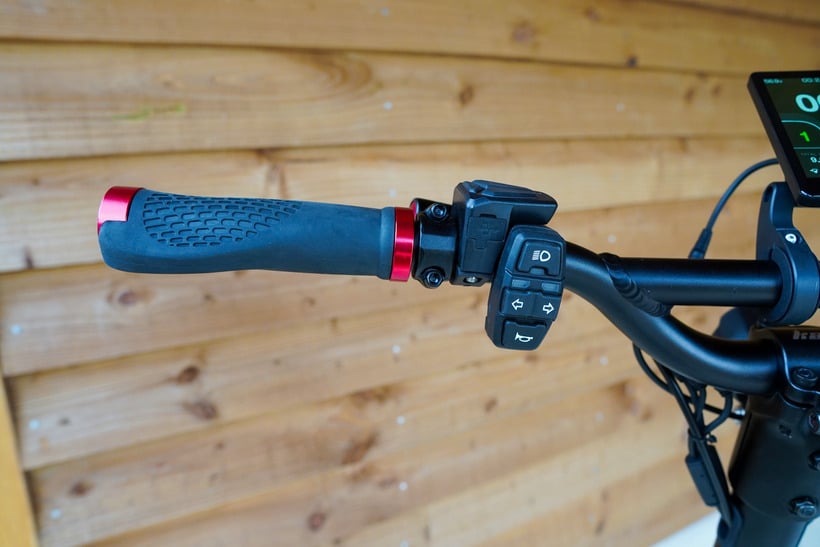Home » Best » Suspension » Top Picks
Top Picks & Comparison: Best Electric Scooters With Suspension (Quick List)
Quick List: Best Full-Suspension Electric Scooters
To find the 5 best full-suspension electric scooters, I tested 45 models.
- SPLACH Turbo – 6/10 Shock Absorption Score (Budget Model)
- Apollo Go – 6/10 Shock Absorption Score (Budget Model)
- Varla Eagle One V2 – 8/10 Shock Absorption Score (Mid-Range Model)
- Apollo City – 7.5/10 Shock Absorption Score (Mid-Range Model)
- Mantis King GT – 9/10 Shock Absorption Score (Premium Model)
Shock Absorption Scores:
0-2: Bone-Jarring Stiffness
3-4: Minimal Cushioning
5-6: Balanced Comfort for Urban Rides
7-8: Versatile Comfort for Mixed Terrain
9-10: Ultimate Comfort for Buttery Smooth Rides, No Matter the Terrain
Best Electric Scooters With Suspension
Best Under $800

SPLACH Turbo
- Shock Absorption Score: 6/10 - Learn More
- Type: Dual springs and swingarms
- Terrain: Sidewalks, streets
Performance Report
Performance Report:
Tester: Josh Frisby (190 lbs, 6.1 ft)
- Top Speed: 28 mph
- Real Speed: 25 mph*
- 0-15 mph: 4.3 s*
- Max Range: 22 miles
- Real Range: 18 miles*
- Braking: 2.4 meters*
- Suspension: 6/10*
- Max Incline: 14 degrees
- Optimal Incline: 9 degrees*
- Weight: 45 lbs
- Load: 265 lbs
Pros & Cons
The Good:
- Outstanding value for money
- Chart-topping speed and acceleration
- Dual swingarm suspension is rare in its price category
- Responsive dual drum brakes outperform competitors
- Exceptionally nimble
- Adjustable handlebar height
- Suitable for both tall and heavy riders
- NFC security system to unlock the scooter
- Low maintenance
- IPX5 water-resistance rating
The Bad:
- The lighting setup scores top marks for style - the problem is, there isn’t enough illumination for night rides
Video Review
Photos
Best Under $1,400

Apollo Go
- Shock Absorption Score: 6/10 - Learn More
- Type: Front spring and rear rubber block
- Terrain: Sidewalks, streets
Performance Report
Performance Report:
Tester: Josh Frisby (197 lbs, 6.1 ft)
- Top Speed: 28 mph
- Real Speed: 25.5 mph*
- 0-15 mph: 3.8 s*
- Max Range: 30 miles
- Real Range: 17.6 miles*
- Braking: 3.1 meters*
- Suspension: 6/10*
- Max Incline: 25 degrees
- Optimal Incline: 12 degrees*
- Weight: 46 lbs
- Load: 265 lbs
Pros & Cons
The Good:
- Ultra-sleek design
- Premium build quality
- Packed full of useful features
- Cybertruck-inspired lights
- Handlebar integrated turn signals
- Well-designed geometry delivers intuitive control and handling
- Best-in-class cockpit ergonomics
- DOT Matrix display is extremely bright and easy to read from any angle
- Comes with a free QuadLock phone case accessory (saving you $30)
- Integrated mobile app for customized performance
- Stable and nimble thanks to its 14-degree rake angle
- Reliable self-healing tires
- A regenerative braking system recycles kinetic energy to recharge the battery by up to 10%
- A 40-inch deck-to-handlebar height and 265 lb load-bearing capacity make it well-suited to tall and heavy riders
- Impeccable cable management
- Extremely low maintenance
- Battery management system ensures long-term health
- Protective IP66 water-resistance rating
The Bad:
- The plastic caps that encapsulate the turn signals are prone to damage
- The taillight is dim during the day
- The clip-in, clip-out folding hook system is a little fiddly
- The handlebars are slightly narrow
Video Review
Photos
Best Under $1,600

Varla Eagle One V2
- Shock Absorption Score: 8/10 - Learn More
- Type: Dual springs and swingarms
- Terrain: Sidewalks, streets, forest trails, hiking paths, dirt tracks
Performance Report
Performance Report:
Tester: Josh Frisby (197 lbs, 6.1 ft)
- Top Speed: 40 mph
- Real Speed: 36.1 mph*
- 0-15 mph: 2.3 s*
- 0-25 mph: 5.8 s*
- 0-30 mph: 9.3 s*
- Max Range: 42 miles
- Real Range: 24.4 miles*
- Braking: 2.0 meters*
- Suspension: 8/10*
- Max Incline: 30 degrees
- Optimal Incline: 18 degrees*
- Weight: 82 lbs
- Load: 330 lbs
Pros & Cons
The Good:
- Top contender in its price class
- Packed full of features
- Extremely well-rounded performance
- Great value for money
- Powerful, yet tameable
- All-terrain powerhouse
- Plush suspension that’s primed for differing terrain
- Handling, control, and maneuverability are all assured
- Throttle response is super smooth thanks to the Sine Wave controllers
- Rock-solid stem thanks to super secure folding mechanism
- Suitable for tall and heavy riders
- Large, bright, and easy-to-read display
- NFC card reader for enhanced security
- Lights are sufficient for night rides
- Sharp and responsive dual hydraulic brakes
- IP54 water resistance rating
The Bad:
- The deck is short, but the well-designed kickplate adds an extra 5.1 inches of space
- The grip tape quickly becomes dirty and is hard to clean
Video Review
Photos
Best Under $1,800

Apollo City
- Shock Absorption Score: 7.5/10 - Learn More
- Type: Front spring and dual rear springs
- Terrain: Sidewalks, streets
Performance Report
Performance Report:
Tester: Josh Frisby (190 lbs, 6.1 ft)
- Top Speed: 32 mph
- Real Speed: 31.2 mph*
- 0-15 mph: 2.3 s*
- 0-25 mph: 6.1 s*
- Max Range: 43 miles
- Real Range: 27 miles*
- Braking: 2.1 meters*
- Suspension: 7.5/10*
- Max Incline: 20 degrees
- Optimal Incline: 13 degrees*
- Weight: 65 lbs
- Load: 265 lbs
Pros & Cons
The Good:
- Competitive performance profile
- Fast acceleration
- Smooth power delivery
- Sublime handling
- Sleek aesthetic
- Feature-rich
- Proprietary design ensures top-class build quality
- Tubeless, self-healing tires
- Shock-absorbing triple spring suspension
- Regen brake recharges the battery by up to 10%
- Intuitive folding mechanism
- Good lighting setup with the best turn signals that I’ve tested
- Battery management system ensures long-term performance
- Integrated mobile app for customized performance
- Fast charging
- 10,000 km warranty
- Low maintenance
- Suitable for tall and heavy riders
- High IP66 water-resistance rating
The Bad:
- The display could be brighter
- Similarly priced models go faster, but the Apollo City Pro’s overall package is superior
Video Review
Photos
Best Under $2,200

Mantis King GT
- Shock Absorption Score: 9/10 - Learn More
- Type: Adjustable hydraulic shocks and swingarms
- Terrain: Sidewalks, streets, forest trails, hiking paths, dirt tracks
Performance Report
Performance Report:
Tester: Josh Frisby (190 lbs, 6.1 ft)
- Top Speed: 43 mph
- Real Speed: 45 mph*
- 0-15 mph: 1.9 s*
- 0-25 mph: 4.0 s*
- 0-30 mph: 5.7 s*
- 0-35 mph: 7.8 s*
- Max Range: 56 miles
- Real Range: 38 miles*
- Braking: 2.1 meters*
- Suspension: 9/10*
- Max Incline: 30 degrees
- Optimal Incline: 18 degrees*
- Weight: 79 lbs
- Load: 265 lbs
Pros & Cons
The Good:
- Best-in-class performance
- Industry-leading design
- Exceptional build and ride quality
- 30A Sine Wave controllers deliver a smooth, fast acceleration
- High-quality Samsung battery
- Adjustable hydraulic suspension
- Terrain-agnostic tires
- Advanced TFT display
- Controllable LED lights
- Superb folding mechanism
- Wide handlebars and ergonomic controls afford excellent control
- Powerful hydraulic brakes
- IPX5 water-resistance rating
The Bad:
- Headlight could be brighter
Video Review
Compare Full-Suspension Electric Scooters
SPLACH Turbo | Apollo Go | Eagle One V2 | Apollo City Pro | Mantis King GT |
|
|---|---|---|---|---|---|
| Where to Buy | SPLACH | Apollo | Varla | Apollo | Kaabo |
| Price | $699 | $1,099 | $1,449 | $1,649 | $1,899 |
| Category | Budget | Budget | Mid-Range | Mid-Range | Premium |
| Award | Best Under $800 | Best Under $1,400 | Best Under $1,600 | Best Under $1,800 | Best Under $2,200 |
| Review | Review | Review | Review | Review | Review |
| Performance | |||||
| Top Speed | 28 mph | 28 mph | 40 mph | 32 mph | 43 mph |
| 0-15 MPH | 4.3 s | 3.8 s | 2.3 s | 2.3 s | 1.9 s |
| 0-25 MPH | n/a | n/a | 5.8 s | 6.1 s | 4.0 s |
| Max Range | 22 miles | 30 miles | 42 miles | 43 miles | 56 miles |
| Tested Range | 18 miles | 17.6 miles | 24.4 miles | 27 miles | 38 miles |
| Shock Absorp. | 6/10 | 6/10 | 8/10 | 7.5/10 | 9/10 |
| Braking | 2.4 meters | 3.1 meters | 2.0 meters | 2.1 meters | 2.1 meters |
| Max Incline | 14 degrees | 25 degrees | 30 degrees | 20 degrees | 30 degrees |
| Optimal Incline | 9 degrees | 12 degrees | 18 degrees | 13 degrees | 18 degrees |
| Specs | |||||
| Motor | 48V 600W | 36V 350W (x2) | 52V 1000W (x2) | 48V 500W (x2) | 60V 1100W (x2) |
| Throttle | Finger | Thumb | Thumb | Thumb | Thumb |
| Battery | 52V 10.4Ah FST | 36V 15Ah FST | 52V 20.8Ah FST | 48V 20Ah FST | 60V 24Ah Samsung |
| Charge Time | 7 hours | 7.5 hours | 10 hours | 4.5 hours | 6 hours |
| Brakes | Dual drums, Electronic | Drum, Regen | Hydraulic Discs (x2), Electronic | Drums (x2), Regen | Hydraulic Discs (x2), Electronic |
| Suspension | Springs, Swingarms | Spring, Rubber Block | Springs, Swingarms | Triple Springs, Swingarms | Adjust. Hydraulic Springs, Swingarms |
| Tire Size | 8.5 inches | 9 inch | 10 inch | 10 inch | 10 inch |
| Tire Type | Air (Inner-Tube), Solid (Rubber) | Air (Tubeless, Self-Healing) | Air (Tubeless) | Air (Tubeless, Self-Healing) | Air (Inner-Tube) |
| Weight | 45 lbs | 46 lbs | 82 lbs | 65 lbs | 74 lbs |
| Load | 265 lbs | 265 lbs | 330 lbs | 265 lbs | 265 lbs |
| Foldability | Folds at Stem & Handlebars | Folds at Stem | Folds at Stem | Folds at Stem | Folds at Stem |
| IP Rating | IPX5 | IP66 | IP54 | IP66 | IPX5 |
| Lights | Stem Strip, Deck LEDs, Taillights, Turn Signals | Headlight, Taillight, Turn Signals | Headlight, Taillight, Deck | Headlight, Taillight, Turn Signals | Headlight, Taillight, Deck, Customizable RGB, Turn Signals |
| Terrain | Street | Street | Street, Off-Road | Street | Street, Off-Road |
How Did I Test the Scooters?
Test Criteria
To find the 5 best electric scooters with suspension, I tested 45 models. Each was evaluated on the design of their suspension system with a focus on adjustability, rebound and compression rates, the balance of shock absorption across the front and rear of the chassis, the amount of travel, and whether they bottomed out. I also assessed the shock-absorbing profile of the tires, as well as each scooter’s ability to tackle different terrain. Based on all of these insights, each scooter was given a shock absorption score from 1 (stiff) to 10 (soft).
Shock Absorption Score
The shock absorption score is an amalgamation of the entire testing process. Rating each scooter out of 10 serves as a quick and easy insight to glean comparative data.
As previously mentioned, the scoring system ranged from 1-10 – where 1 was extremely stiff and 10 was extremely soft – but, in the interest of selecting the top-performing scooters relative to their price, I made sure to only choose those with scores of 5 or above.

For context, scooters that scored 5-6 delivered a comfortable ride across urban terrain, while any scoring 7 or above could tackle unpredictable environments (i.e. forest tracks, dirt paths, etc). The higher the score, the more plush the ride.
Suspension Type
My first port of call when testing each scooter’s suspension was to identify their setups. The best scooters typically sported systems centered on either hydraulics or springs, though some also donned effective rubber torsion systems.

A quick visual assessment was conducted to establish the suspension that I was working with. This may sound trivial but understanding the components can play a key role in how you get the best from them. For example, while springs are ready to go straight out of the box, other systems like those that sport rubber can take time to break in.
Adjustability
To put it simply, some suspension systems could be adjusted while others couldn’t. However, for those that could, the degree of adjustability varied. For example, I found that some springs could be tightened or loosened using a C-spanner, while others had small dials that you could twist with your fingers. In some cases, there were a couple of scooters (cough…Dualtron) that claimed to have 45-step adjustable suspension systems, but the process to change their configuration was extremely complex, rendering them unpractical.

To address the nuances between the different suspension setups, I reported on how easy they were to adjust, as well as the impact that the changes had on performance (i.e. did the adjustments improve shock absorption).
Rebound and Compression Rates
Throughout my tests, it became clear that rebound and compression rates are key to not only your comfort but also the scooter’s handling.
To test this, I assessed whether the suspension felt controlled or bouncy. The top performers were able to roll over obstacles smoothly, while those at the lower end of the spectrum felt like pogo sticks.
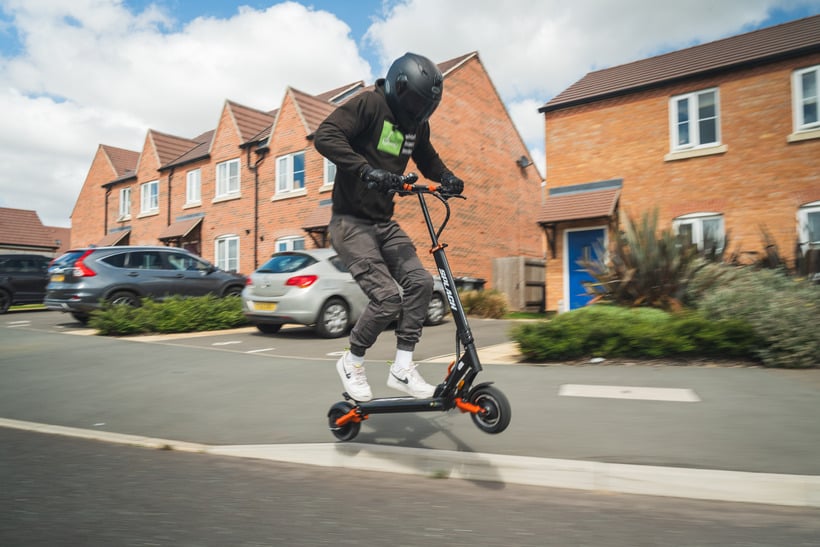
Scooters that had hydraulic shocks were the front runners since they had the ability to slow the rebound rate of their springs, thereby preventing them from immediately pinging out after compression.
Balance of Shock Absorption
Even if a scooter has a dual suspension system, it doesn’t necessarily mean that both play equal parts. There can, at times, be a mismatch in the equilibrium between the front and rear of a scooter – a prime example of this is the Apollo Pro (it was plush at the front, stiff at the rear).

To ensure the utmost comfort, the best configurations are those that strike a balance.
As with the rest of the tests, I took each scooter out on multiple runs. For urban models, the tests were confined to smooth roads and pot-holed streets; for off-roaders, the assessments were extended to dirt tracks and forest trails.
Amount of Travel
The amount of travel that a suspension system provides is a key indicator of its performance. As a rule of thumb, the greater the travel, the more plush the ride. Hitting the sweet spot, however, is where the magic happens.

Here, I garnered insights from my hands-on tests to determine whether each achieved a level of travel suitable for its claimed terrain and purpose.
Bottoming Out
Unfortunately, some scooters can bottom out, which in other words, means the springs clank together when fully compressed.

To address this, I made sure to only select the scooters that used rubber bushings to soften the contact of the springs.
Shock Absorbing Profile of the Tires
While springs, rubber bushings, and swingarms all play a significant role in a scooter's ability to soak up shocks, their performance can be negated by tires that aren’t of equal quality.
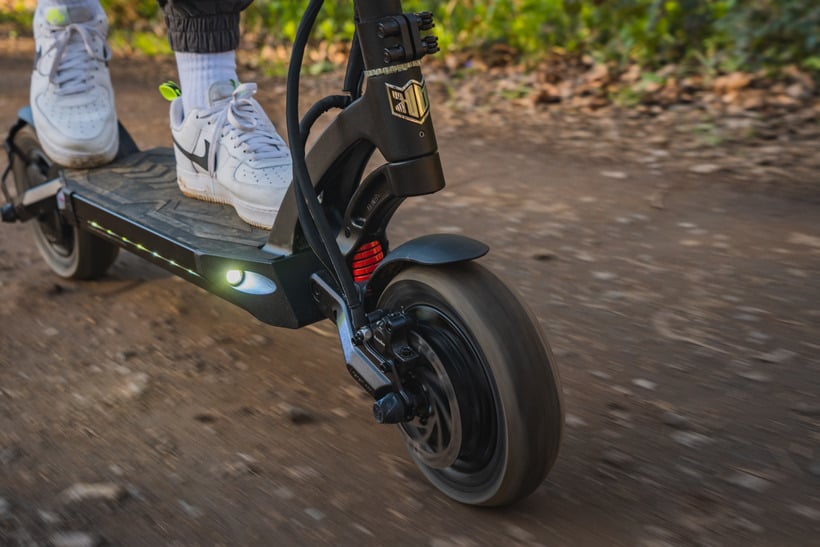
In identifying the best scooters, I found that larger air-filled tires delivered the most amount of cushioning and therefore worked as supplements to the suspension. There were some cases, however, where a mixture of solid and pneumatic tires delivered just as good performance.
Ability to Tackle Different Terrain
Manufacturers often specify the types of terrain that their scooters are suitable for, but sometimes the performance doesn’t match up to the marketing.
So, to address this, I reported on each scooter's capabilities following a series of all-terrain tests.


